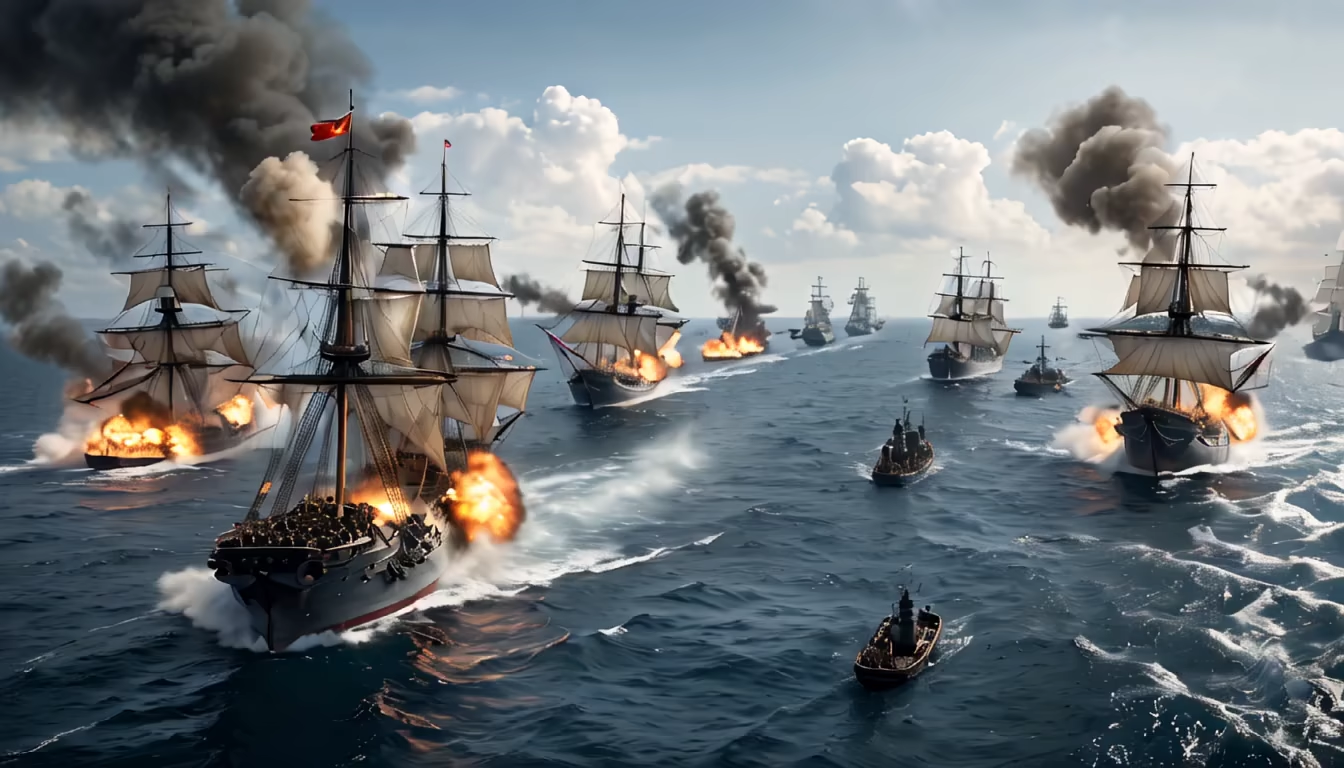Prompt: Visualize an image split into two contrasting scenes: on one side, portray the Chinese government's crackdown on the opium trade, with officials and workers destroying crates of opium, while on the other side, depict a stern and displeased British envoy or representatives reacting to this interference. Show their dissatisfaction or anger through body language or facial expressions, symbolizing Britain's resistance to China's attempts to disrupt their profitable opium trade. This contrast aims to emphasize Britain's displeasure and resistance towards the Chinese interference in their lucrative trade.
Style: Photographic
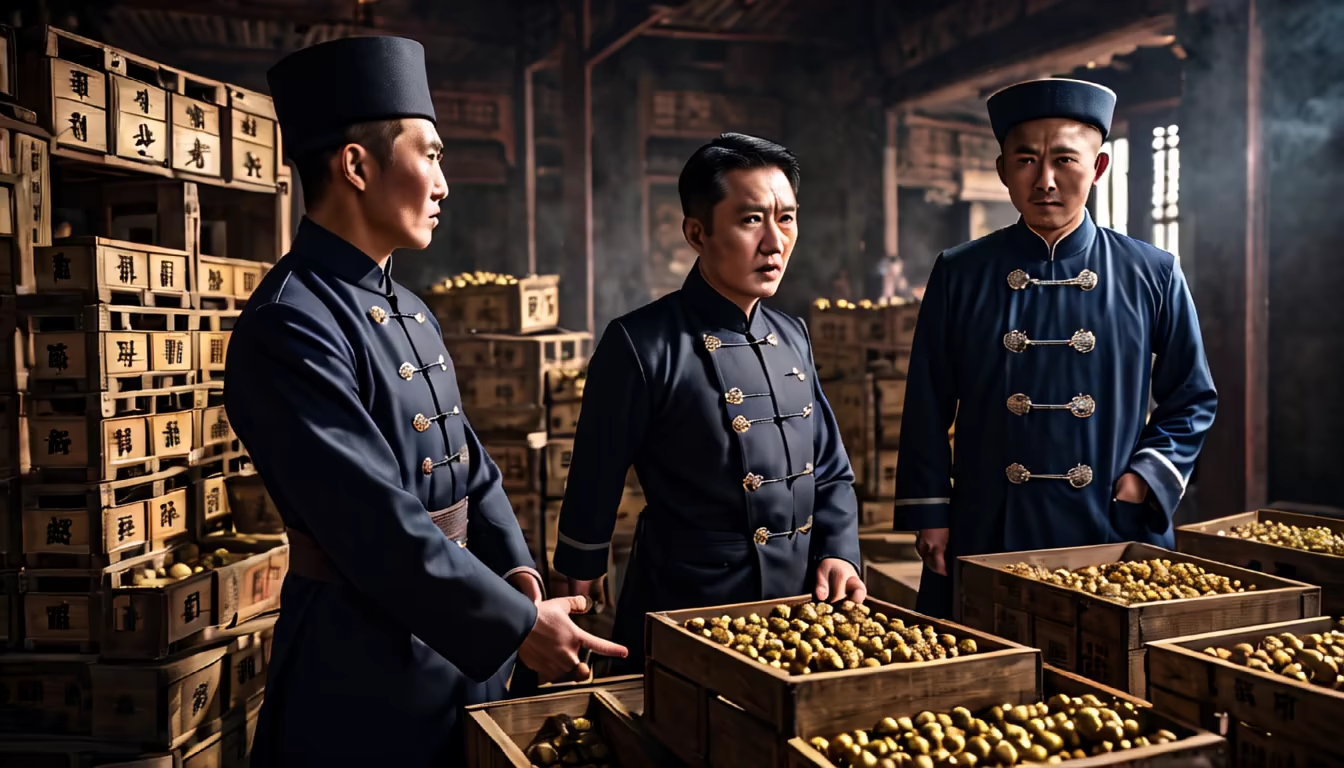

Prompt: Visualize an image split into two parts: on one side, depict British merchants or ships trading opium, surrounded by wealth and prosperity symbols like coins or opulent items. On the other side, portray the Chinese government or officials struggling to contain the opium trade, trying to stop the flow of the drug into their country, perhaps through the confiscation or destruction of opium crates.In the middle, create a visual representation of tension and conflict, symbolized by opposing forces or barriers between the two sides. This image aims to illustrate the fundamental cause of the conflict—the profitable opium trade for the British contrasted with the Chinese efforts to suppress it, emphasizing the stark differences in interests that led to the escalation of tensions and ultimately the conflict between the two nations.
Style: Photographic


Prompt: Visualize an image split into two contrasting scenes: one side depicting the British interests in China, possibly through merchants, ships, or symbols of trade, showcasing their economic endeavors. On the other side, portray Commissioner Lin Zexu overseeing the dramatic destruction of opium crates, exuding determination and authority.In the center, create a dynamic visual of the opium being seized and destroyed, symbolizing the audacious move made by Lin Zexu. Show reactions from both sides – the British representatives displaying shock or agitation, while Lin Zexu remains resolute. This image aims to capture the boldness of Lin Zexu's actions, highlighting the direct challenge it posed to British interests in China, setting the stage for escalating tensions and conflict.
Style: Photographic


Prompt: Imagine an image split into two halves: one side showcasing the Chinese government's efforts to ban the opium trade, with officials destroying opium stocks and implementing anti-opium measures. This could be depicted through scenes of crackdowns on opium dens or the destruction of confiscated opium. On the other side, illustrate the intended outcome, with visuals representing a more stable and balanced society, healthier individuals, and a symbolic portrayal of restored trade equilibrium. The image would aim to highlight the proactive steps taken by the Chinese government to safeguard their population and restore order amid the opium crisis.
Style: Photographic

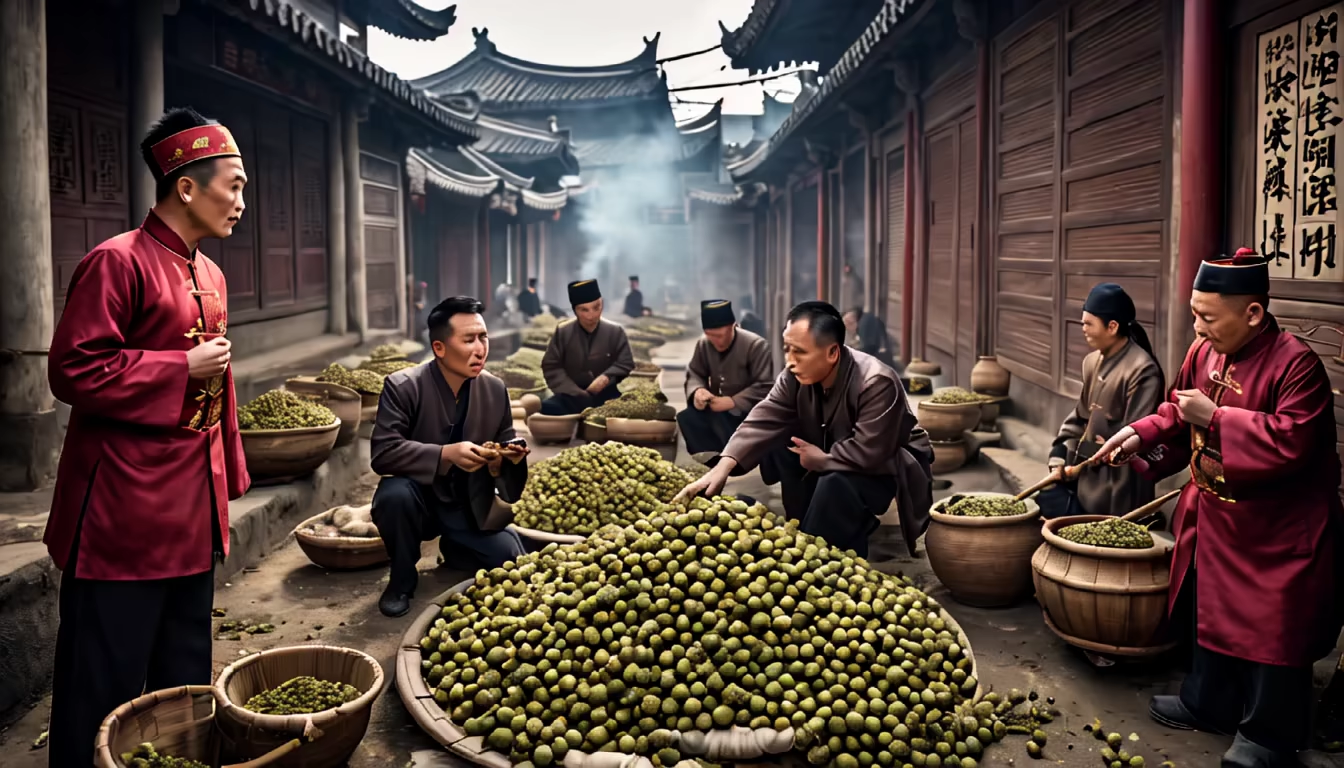
Prompt: Picture an image split into two scenes: one portraying the struggle of British merchants attempting to trade their goods in China, facing barriers and restrictions. The other side could depict a depiction of opium being traded by British merchants to Chinese traders, highlighting the solution Britain found to address their trade imbalance. You might show ships arriving with crates of opium contrasted with the difficulty British traders faced with their own goods. The visual contrast can emphasize the role of opium as a solution for Britain's trade predicament.
Style: Cinematic

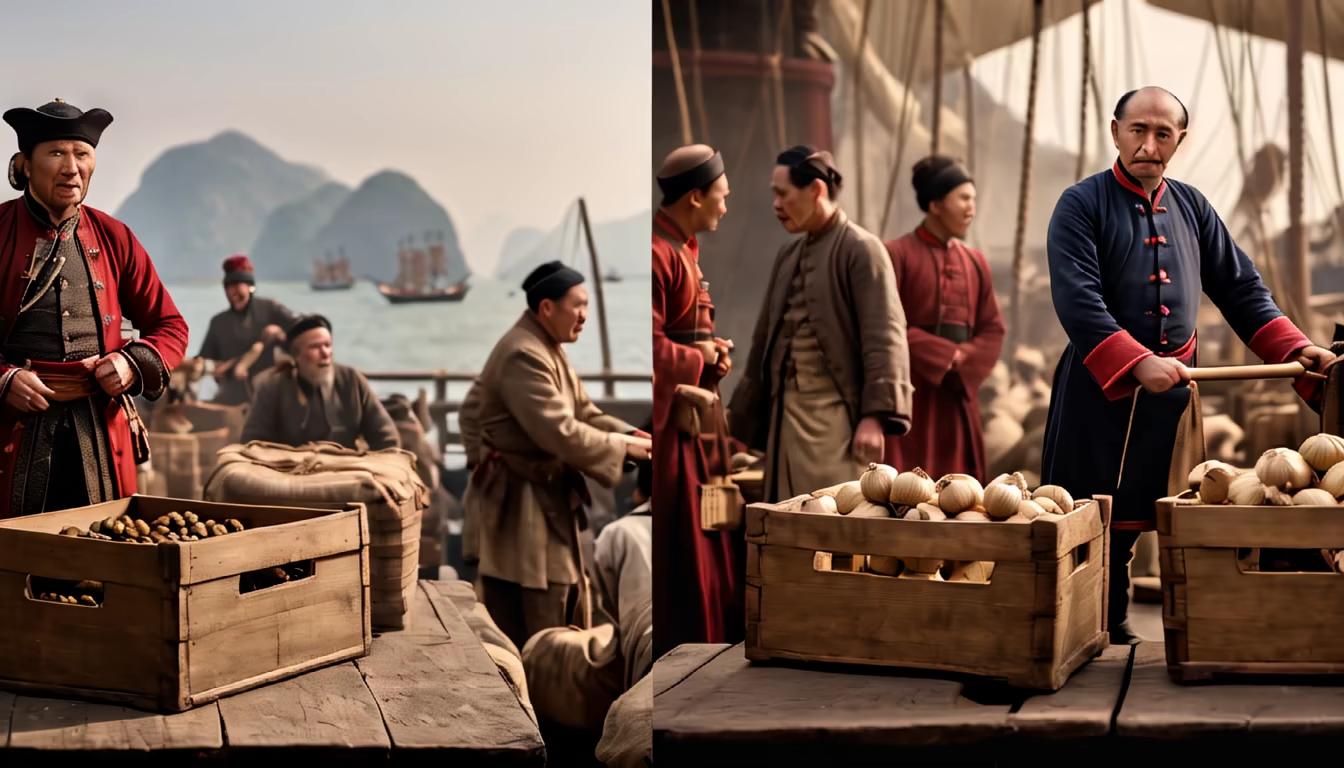
Prompt: Imagine an image split into two parts. On one side, portray the devastating effects of the opium epidemic in China: scenes of suffering individuals, hospitals overwhelmed, and communities in distress due to addiction and health issues caused by opium abuse. On the other side, depict a visual representation of China's trade deficit during the Opium War, showcasing the outflow of silver and wealth from China to Britain due to the opium trade. The image could juxtapose these elements, highlighting the dual impact of a public health crisis and economic turmoil during this historical period.
Style: Photographic
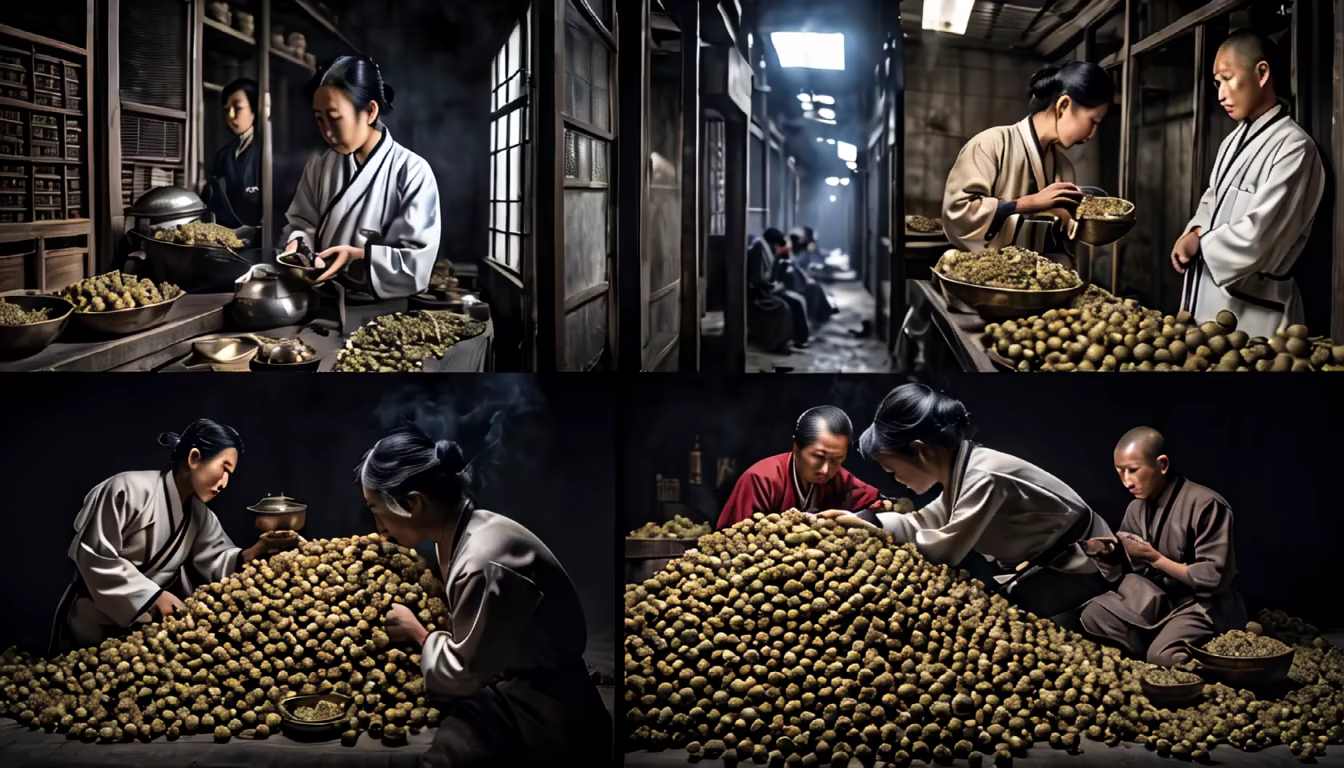
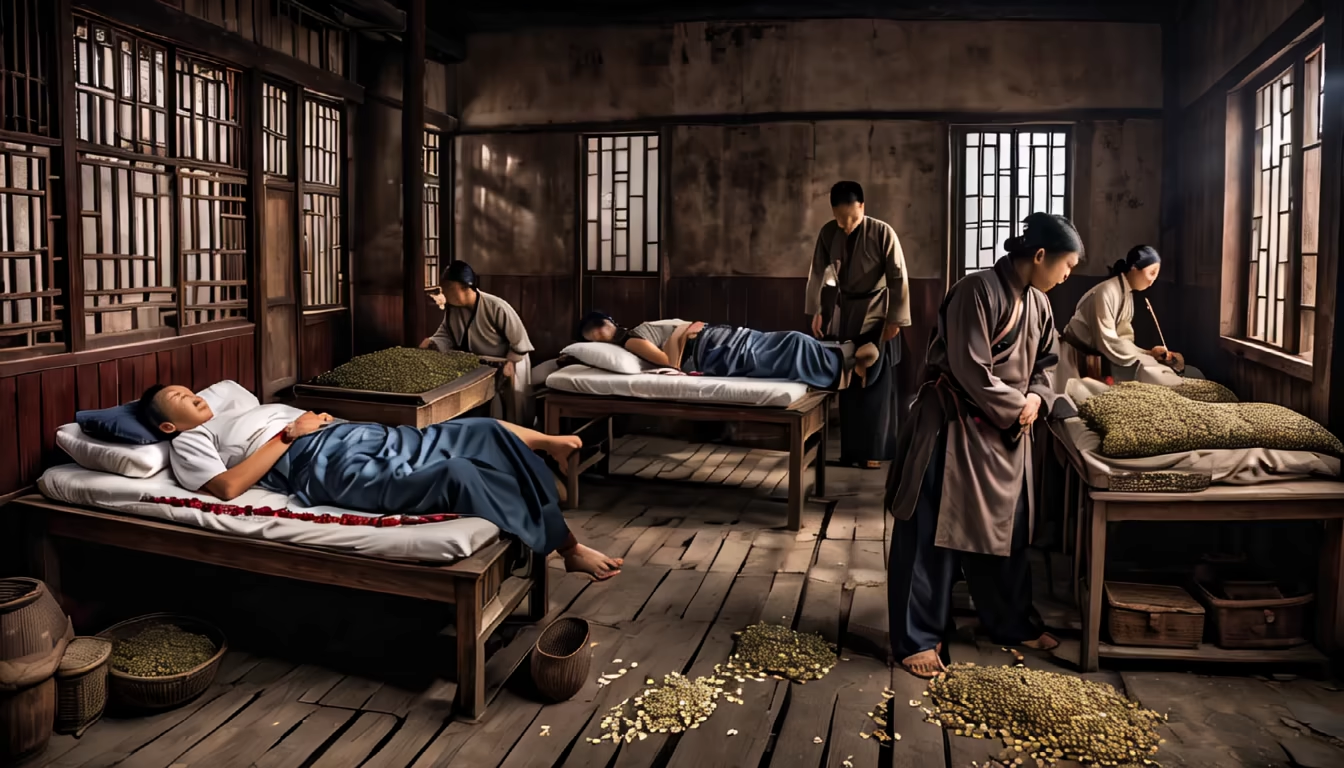
Prompt: Imagine an image split into two parts. On one side, portray the devastating effects of the opium epidemic in China: scenes of suffering individuals, hospitals overwhelmed, and communities in distress due to addiction and health issues caused by opium abuse. On the other side, depict a visual representation of China's trade deficit during the Opium War, showcasing the outflow of silver and wealth from China to Britain due to the opium trade. The image could juxtapose these elements, highlighting the dual impact of a public health crisis and economic turmoil during this historical period.
Style: Photographic
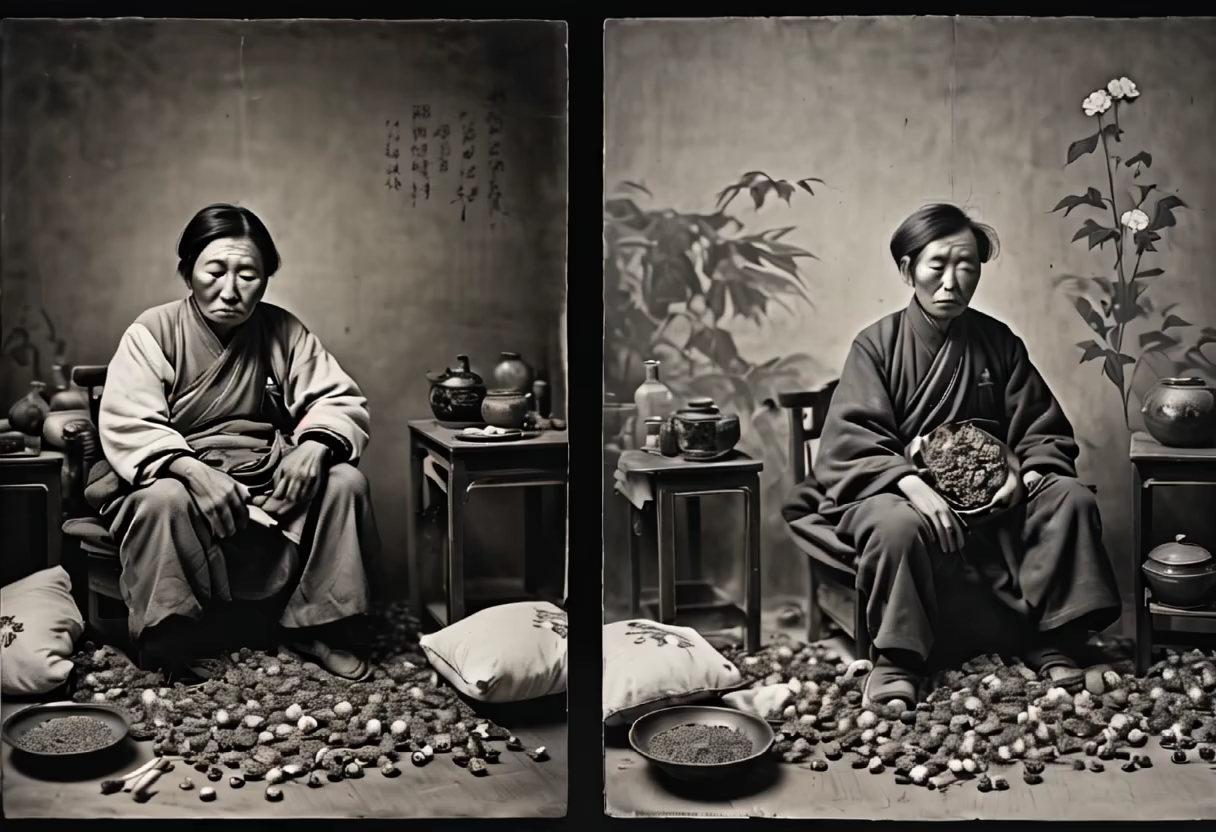
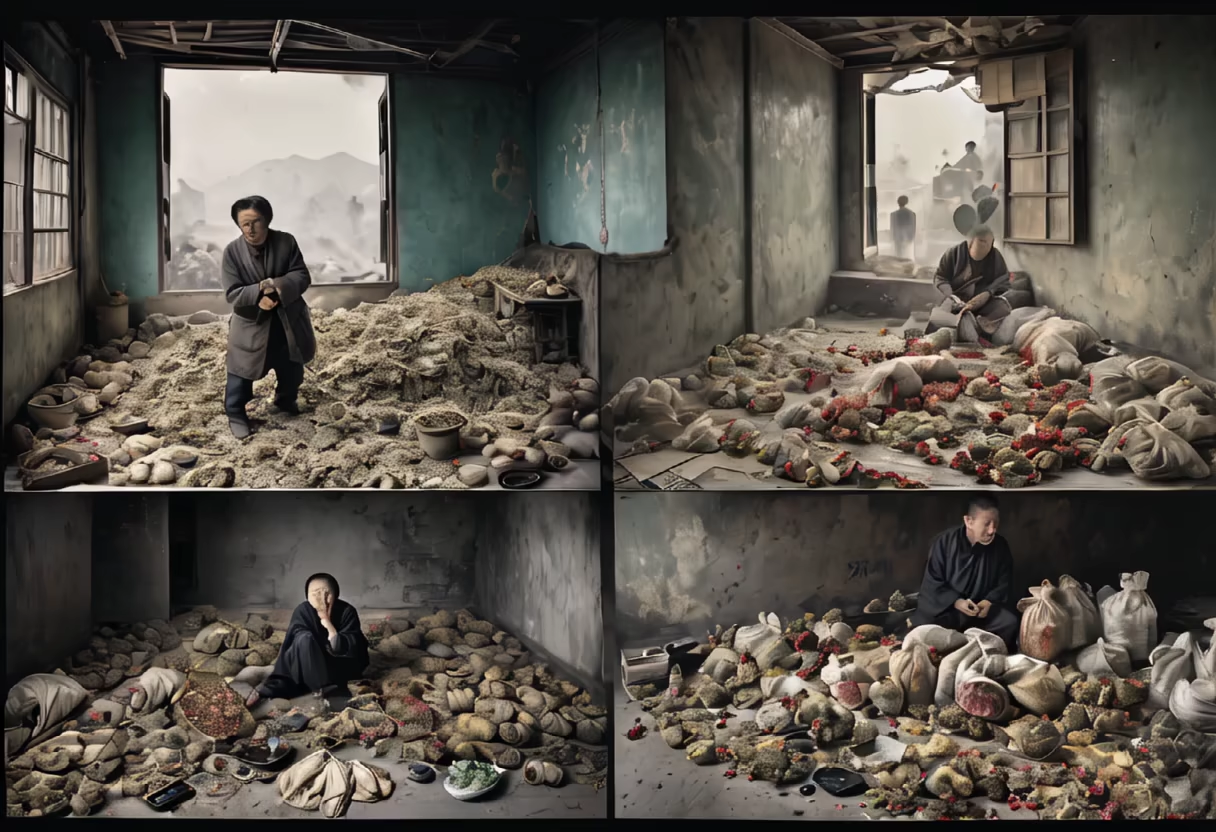
Prompt: Explore the pivotal role of Commissioner Lin Zexu in combating the opium trade when dispatched by the Chinese Emperor to Guangdong Province, the heart of the opium trade. Delve into Lin Zexu's background, beliefs, and the strategies he employed to staunchly oppose the opium trade. Analyze the socio-political climate of Guangdong Province and the challenges faced by Lin Zexu in his efforts to eradicate opium. Investigate the confrontations and negotiations between Lin Zexu and British merchants, considering the clash of ideologies regarding trade, morality, and sovereignty. Examine the impact of Lin Zexu's actions on both the Chinese government's stance on the opium trade and the perception of Western powers. Assess the significance of Lin Zexu's mission and the legacy of his anti-opium efforts in shaping Chinese history, international relations, and the discourse on trade ethics.
Style: Photographic
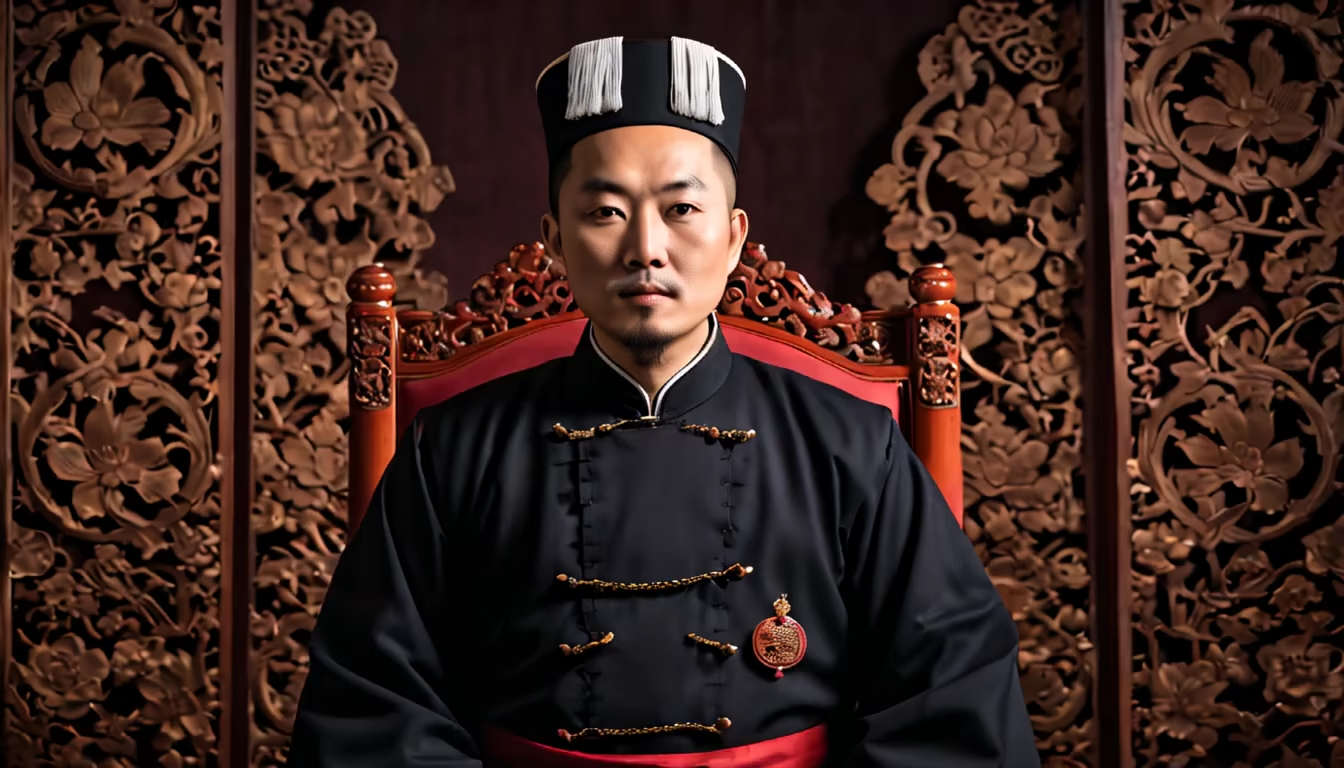

Prompt: The opium trade in the 19th century significantly altered international relations, sparking what would become known as the First Opium War. Delve into the complex web of events and interests that led to the outbreak of this conflict. Explore the socio-economic factors behind the rapid growth of the opium trade between China and Western powers. Investigate the clash between Chinese efforts to prohibit the trade and the lucrative interests of British merchants exporting opium into China. Analyze the diplomatic tensions and power dynamics between China and Britain that culminated in armed conflict. Consider the perspectives of both sides and the sequence of events that ultimately gave rise to the First Opium War. Evaluate the consequences and long-term implications of this conflict on global trade, diplomatic relations, and the sovereignty of nations involved.
Style: Photographic
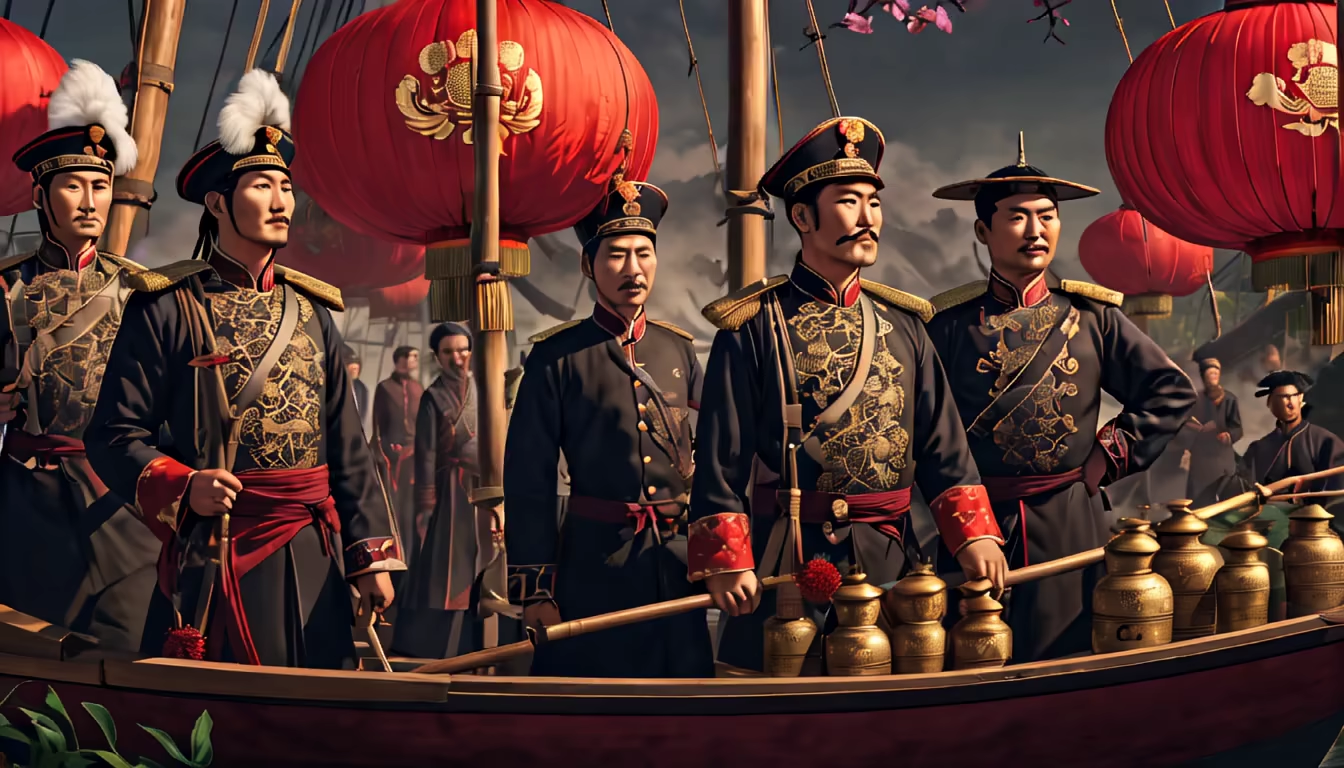
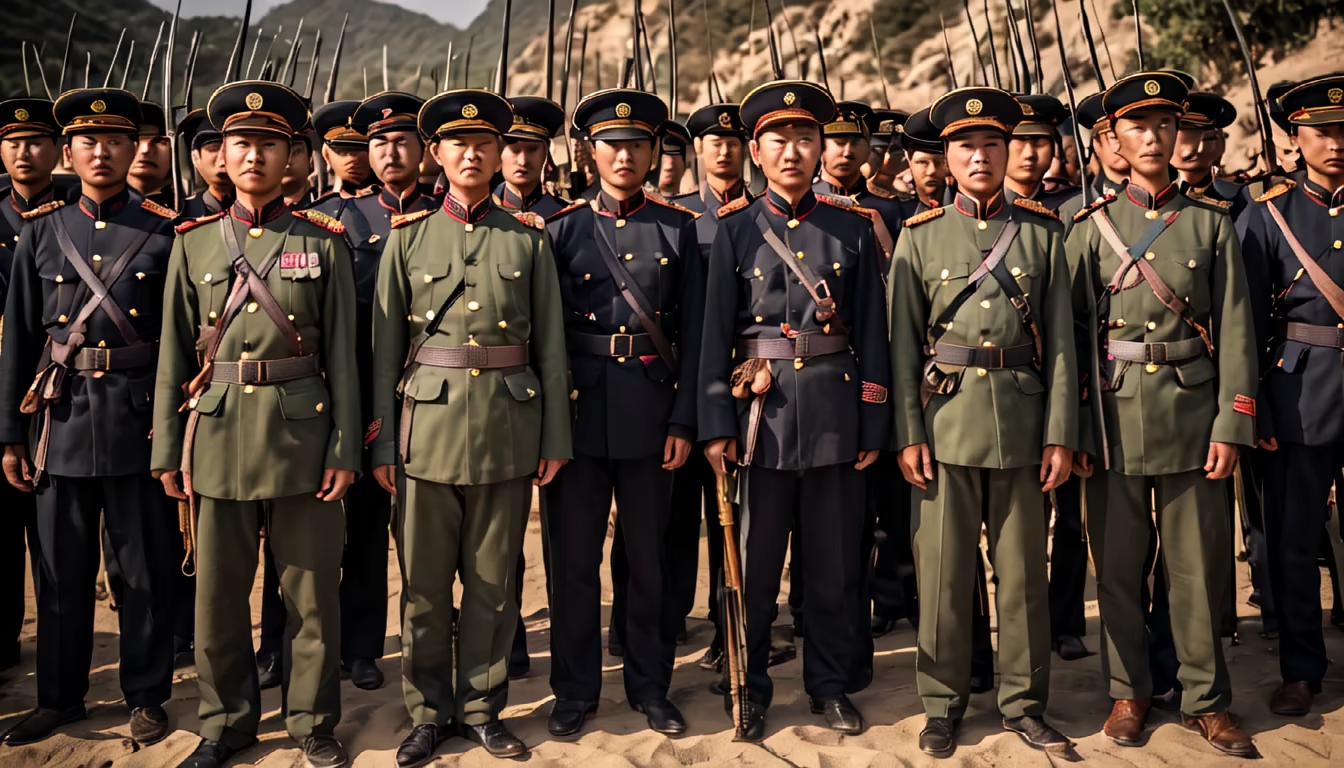
Prompt: In the 19th century, China faced a profound internal struggle in its attempt to suppress the opium trade. Explore the motivations and efforts of the Chinese government to combat the opium epidemic within their borders. Investigate the societal and cultural impacts of opium addiction on the Chinese population. Examine the measures implemented by Chinese authorities to suppress the opium trade and curb addiction, considering both the successes and challenges they encountered. Analyze the political, economic, and social factors that fueled China's determination to halt the opium trade despite significant pressure from Western powers. Explore the clash between China's desire for social stability and sovereignty and the commercial interests of Western traders. Reflect on the cultural and moral dimensions of China's struggle against the opium trade and its significance in shaping China's relationship with the outside world
Style: Photographic

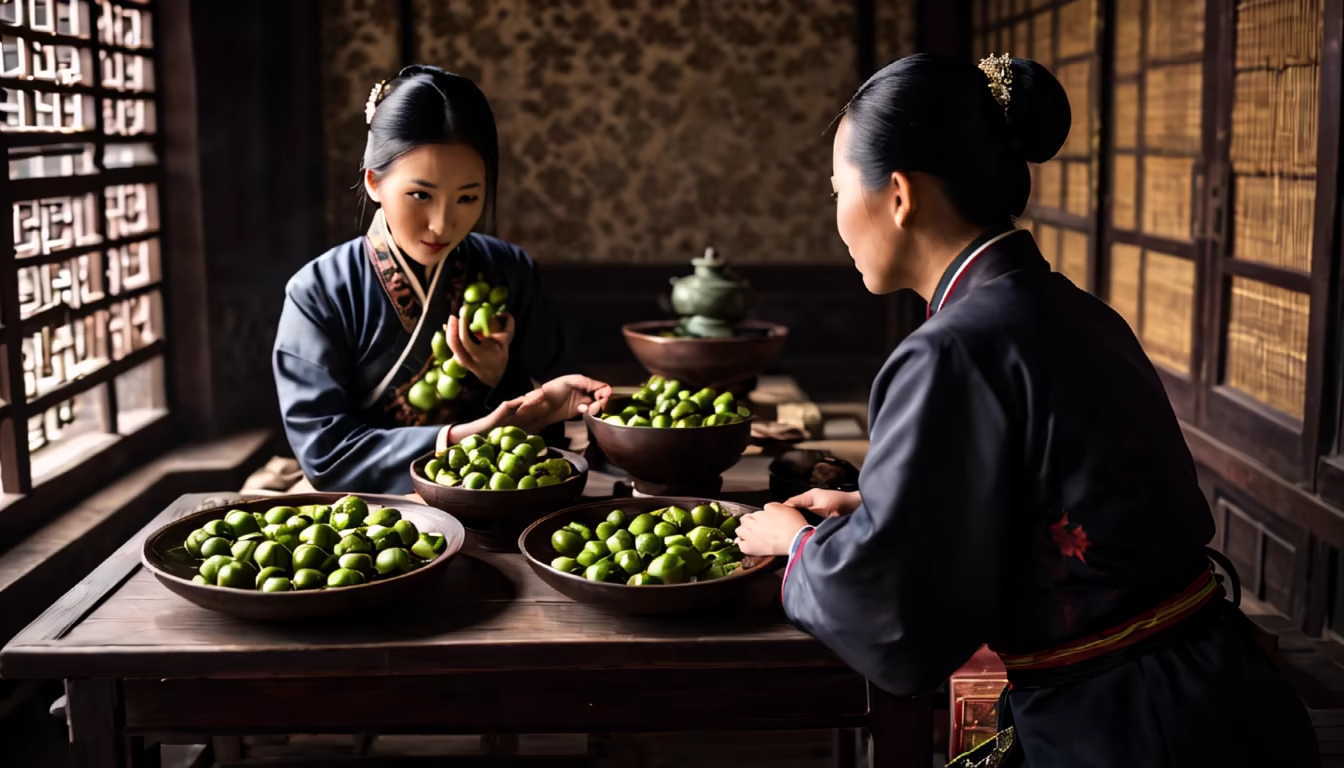
Prompt: How about an image showing a historical trade scenario between China and Britain? It could feature Chinese goods like tea, silk, and porcelain being loaded onto ships headed to Britain, while British goods or representatives struggle to gain entry into China, illustrating the one-sided nature of the trade relationship. This could be depicted through contrasting scenes or visuals to highlight the unequal exchange.
Style: Photographic


Prompt: Imagine an image split into two parts: one side depicting a vibrant, bustling scene in China with various coveted goods like tea, silk, and porcelain being traded and displayed. On the other side, portray a less dynamic scene in Britain, showcasing a limited display of British goods struggling to gain entry into China. Overlaying these scenes, visualize a bridge formed by opium, connecting the two sides. On the British side, ships loaded with crates of opium arrive, while on the Chinese side, depict the consumption and trade of opium becoming prominent, symbolizing Britain's solution to address the trade imbalance. This contrast visually illustrates how opium became the link between the desires of Britain and the previously unattainable Chinese market.
Style: Cinematic
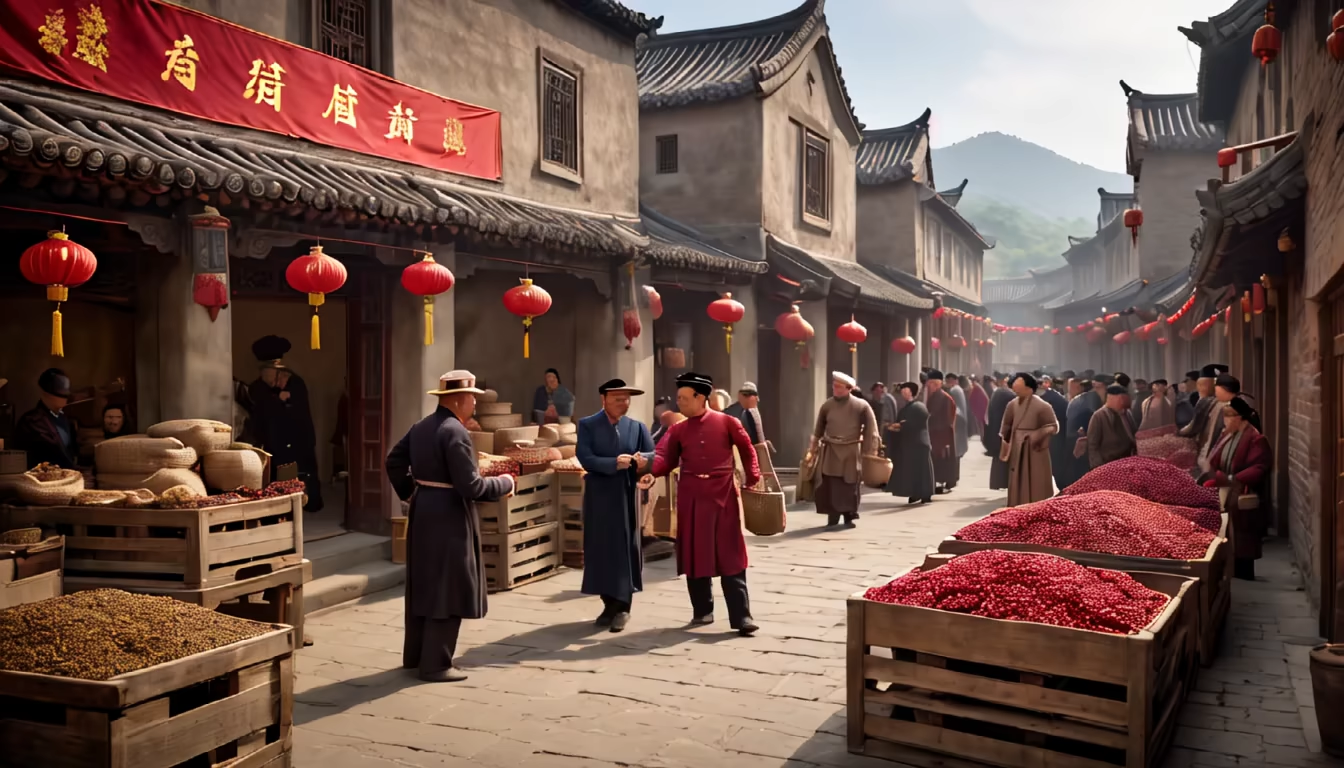

Prompt: The opium trade of the 19th century was a contentious issue that significantly influenced international relations. Explore the British involvement in the opium trade and its impact on relations with China. Investigate how the opium trade became a source of considerable profits for British merchants and traders. Delve into the economic motivations behind Britain's active participation in the opium market despite opposition from the Chinese authorities. Analyze the social, economic, and political repercussions of these profits on both the British economy and their relations with China. Consider the ethical dimensions of profiting from a trade that led to addiction and social devastation in China. Examine the role of profit-driven motives in exacerbating tensions and contributing to the conflict arising from the opium trade. Evaluate the implications of prioritizing economic interests over ethical considerations in international relations.
Style: Photographic
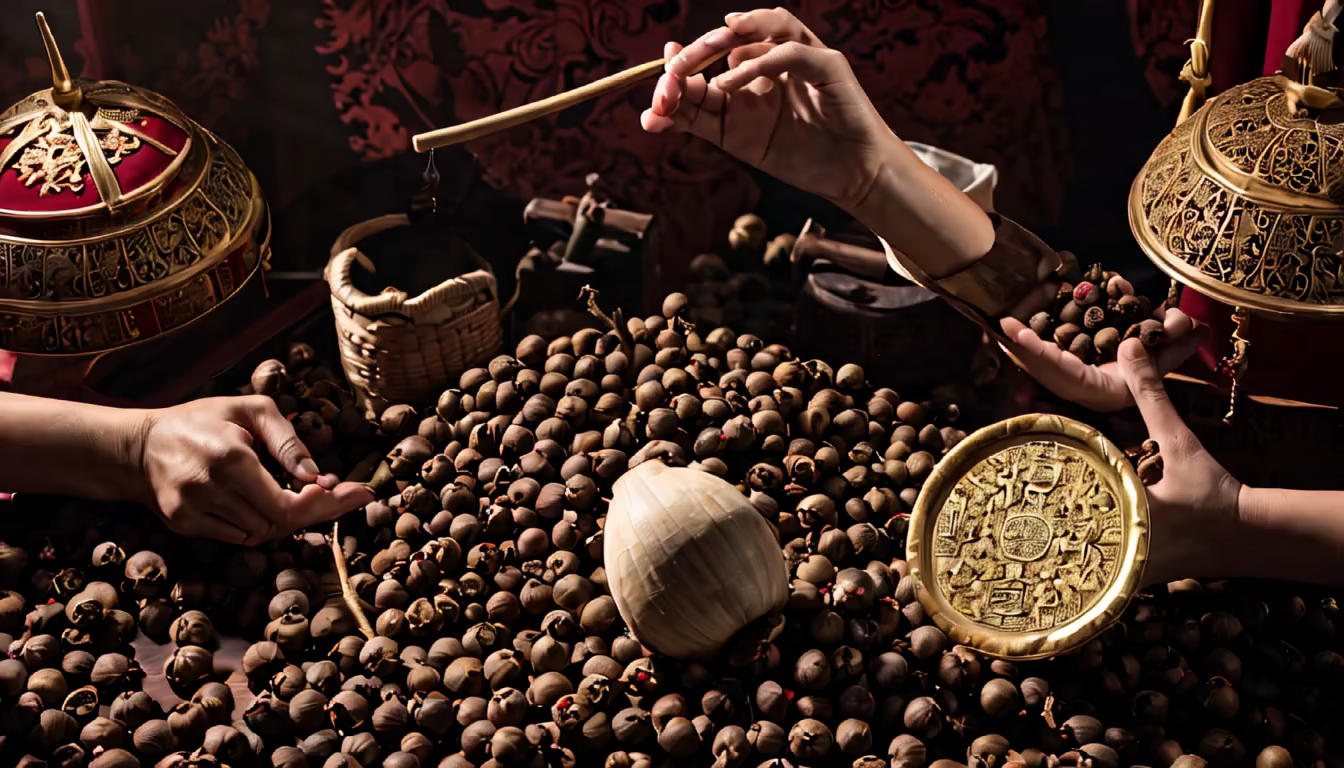
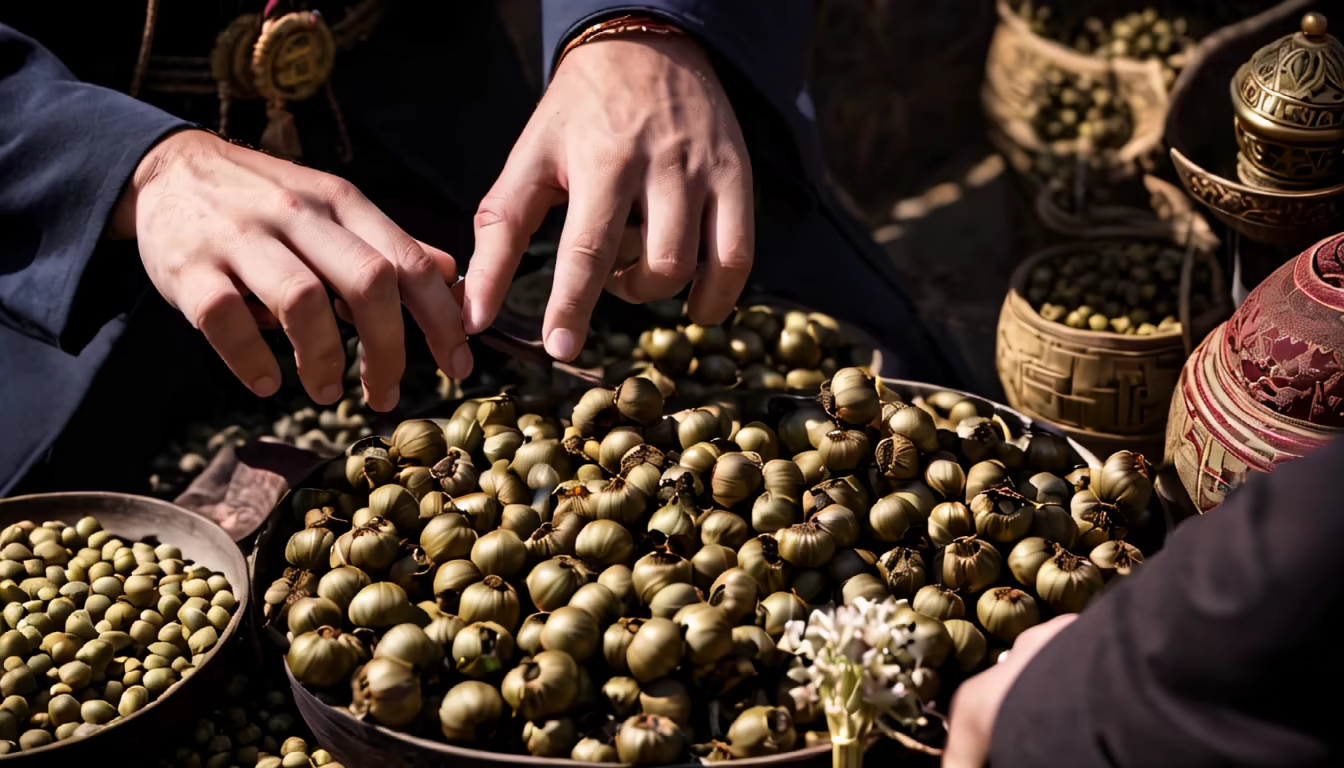
Prompt: How about an image showing a historical trade scenario between China and Britain? It could feature Chinese goods like tea, silk, and porcelain being loaded onto ships headed to Britain, while British goods or representatives struggle to gain entry into China, illustrating the one-sided nature of the trade relationship. This could be depicted through contrasting scenes or visuals to highlight the unequal exchange.
Style: Cinematic


Prompt: Explore the pivotal role of Commissioner Lin Zexu in combating the opium trade when dispatched by the Chinese Emperor to Guangdong Province, the heart of the opium trade. Delve into Lin Zexu's background, beliefs, and the strategies he employed to staunchly oppose the opium trade. Analyze the socio-political climate of Guangdong Province and the challenges faced by Lin Zexu in his efforts to eradicate opium. Investigate the confrontations and negotiations between Lin Zexu and British merchants, considering the clash of ideologies regarding trade, morality, and sovereignty. Examine the impact of Lin Zexu's actions on both the Chinese government's stance on the opium trade and the perception of Western powers. Assess the significance of Lin Zexu's mission and the legacy of his anti-opium efforts in shaping Chinese history, international relations, and the discourse on trade ethics.
Style: Cinematic

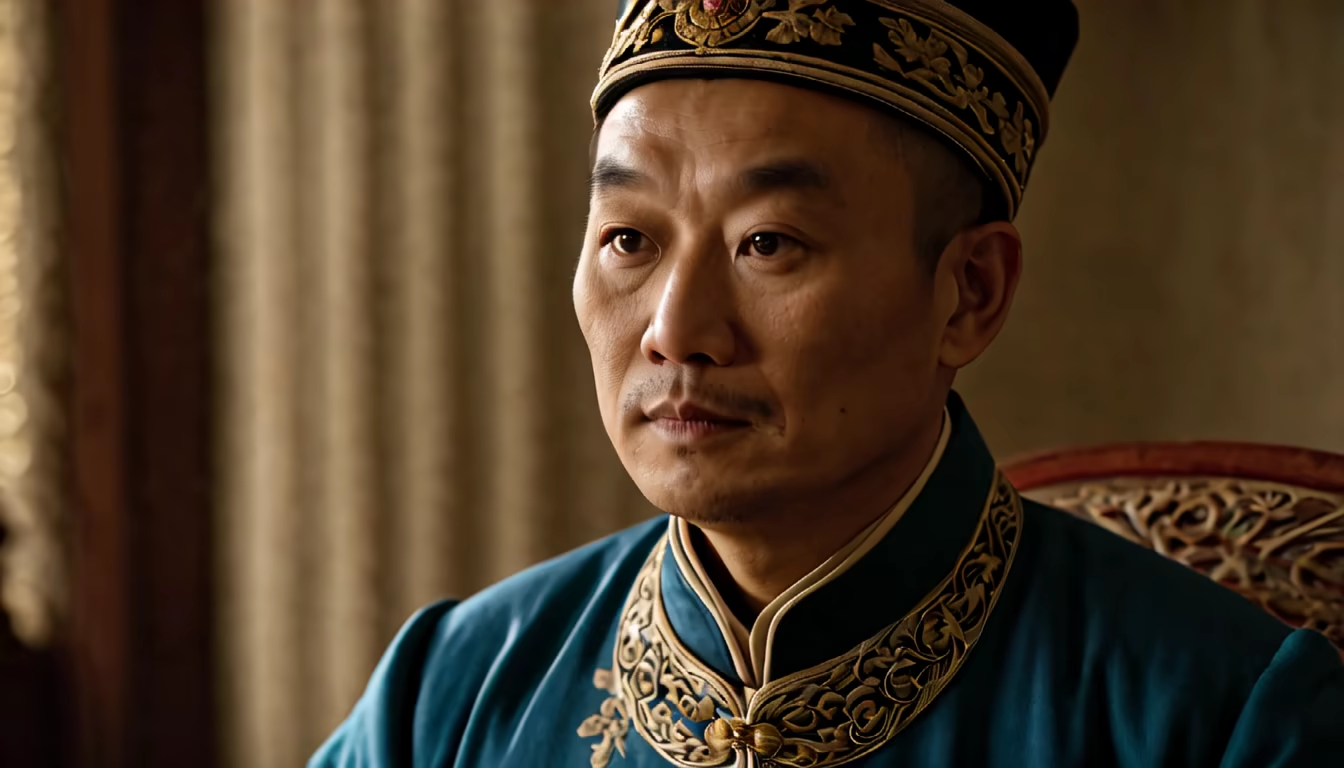
Prompt: In the early 19th century, China faced a devastating crisis with the widespread opium trade. The Chinese government took bold steps to curb this trade, recognizing the destructive impact of opium addiction on its people and society. Craft a narrative exploring the multifaceted efforts initiated by the Chinese authorities to ban the opium trade. Consider the historical, social, and economic implications of this decision. Highlight the challenges faced by the government in implementing these measures and the ways in which they aimed to restore balance and protect their population from the ravages of addiction. You could delve into the socio-political landscape of the time, the global influences on the opium trade, and the strategies employed by the Chinese government to combat this crisis.
Style: Photographic

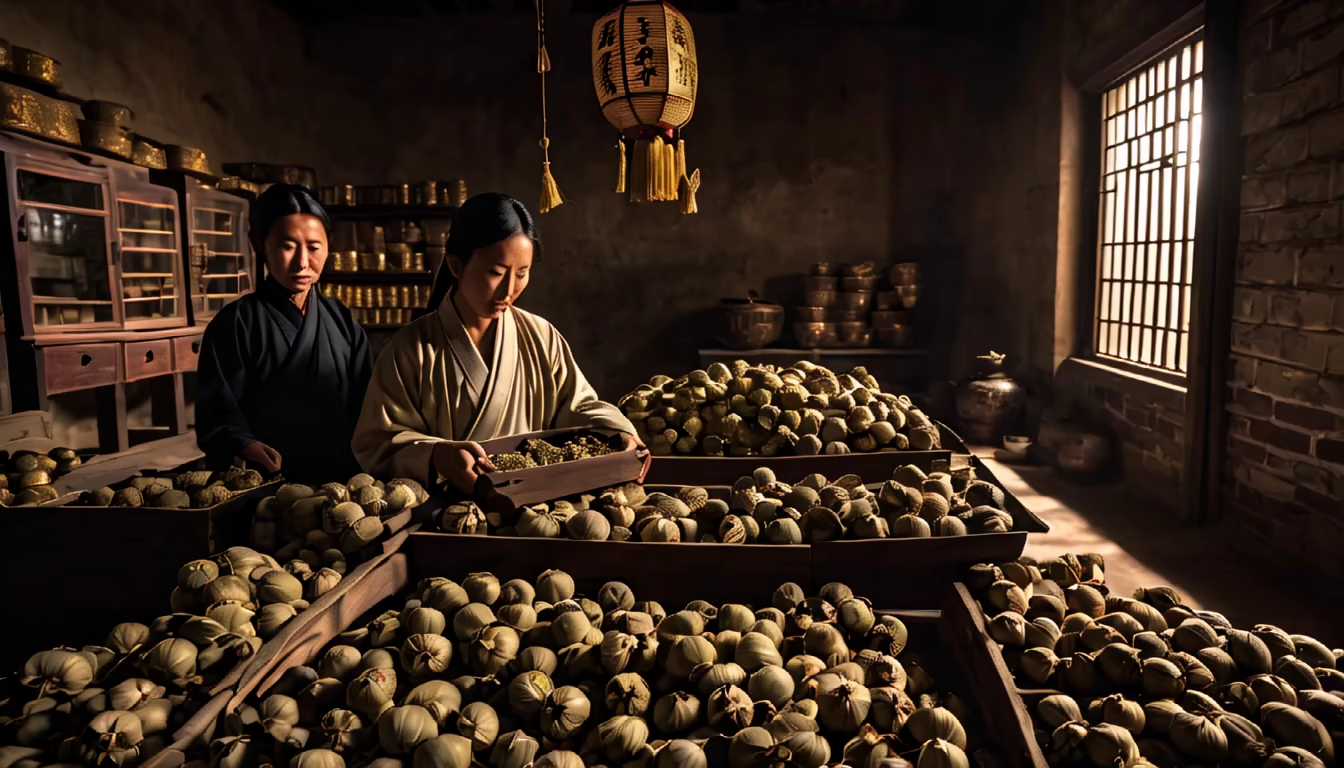
Prompt: The Opium Wars of the 19th century were pivotal conflicts that stemmed from the opium trade between China and Western powers. Investigate the intricate dynamics of the opium trade during the Opium Wars. Analyze the mechanisms by which the opium trade became a catalyst for conflict between China and Britain. Explore the economic, political, and social ramifications of the opium trade on both sides, considering the British pursuit of profit and the Chinese efforts to suppress the trade. Examine how the opium trade transformed diplomatic relations, contributing to a significant imbalance in power dynamics. Evaluate the sequence of events during the Opium Wars, highlighting the role of the opium trade as a primary cause and the subsequent implications for global trade, sovereignty, and international relations. Delve into the perspectives of key stakeholders involved and consider the long-term consequences of these conflicts on the affected nations and global perceptions of trade and imperialism.
Style: Cinematic


Prompt: In the 19th century, China faced a profound internal struggle in its attempt to suppress the opium trade. Explore the motivations and efforts of the Chinese government to combat the opium epidemic within their borders. Investigate the societal and cultural impacts of opium addiction on the Chinese population. Examine the measures implemented by Chinese authorities to suppress the opium trade and curb addiction, considering both the successes and challenges they encountered. Analyze the political, economic, and social factors that fueled China's determination to halt the opium trade despite significant pressure from Western powers. Explore the clash between China's desire for social stability and sovereignty and the commercial interests of Western traders. Reflect on the cultural and moral dimensions of China's struggle against the opium trade and its significance in shaping China's relationship with the outside world.
Style: Cinematic
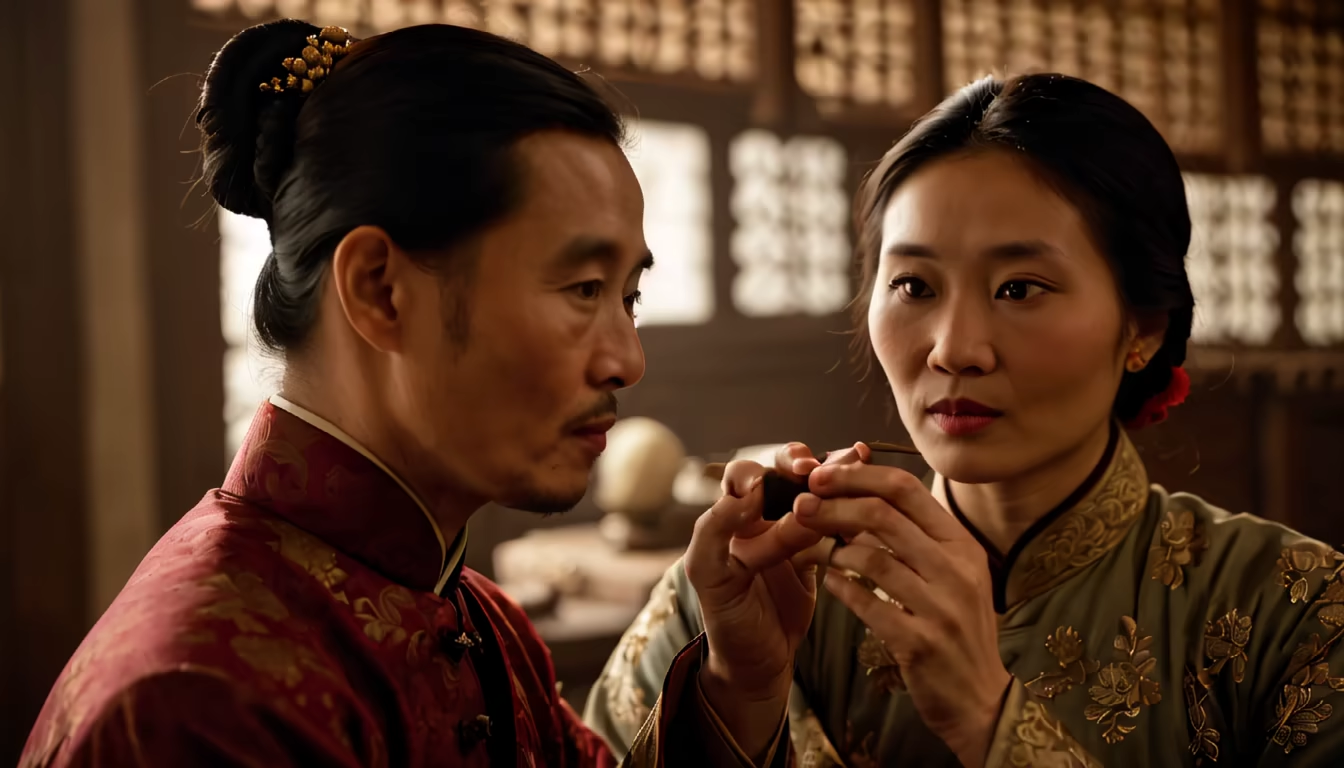

Prompt: An evocative visual portrays a dramatic maritime scene from the historical period of the Opium Wars. The image encapsulates the intensity of naval warfare during this time, showcasing a fierce confrontation between British and Chinese naval forces on the open sea. The foreground exhibits the tumultuous waters, roiled by the clash of warships, their sails taut against the wind. British war vessels, sleek and sturdy, engage in a strategic formation, cannons protruding from their sides, billowing smoke and fire as they exchange volleys with Chinese junks, adorned with colorful sails and intricate designs. The horizon is dominated by the vast expanse of the sea, with the sky painted in hues of orange and red from the setting sun, casting a fiery glow on the tumultuous scene. In the distance, the silhouettes of more ships approach, indicating the ongoing nature of the conflict and the continuous struggle for naval dominance. This image encapsulates the pivotal battles fought at sea during the Opium Wars, showcasing the high-stakes confrontations, technological disparities, and the crucial role of naval power in shaping the outcome of the conflicts between the British and Chinese forces.
Style: Photographic

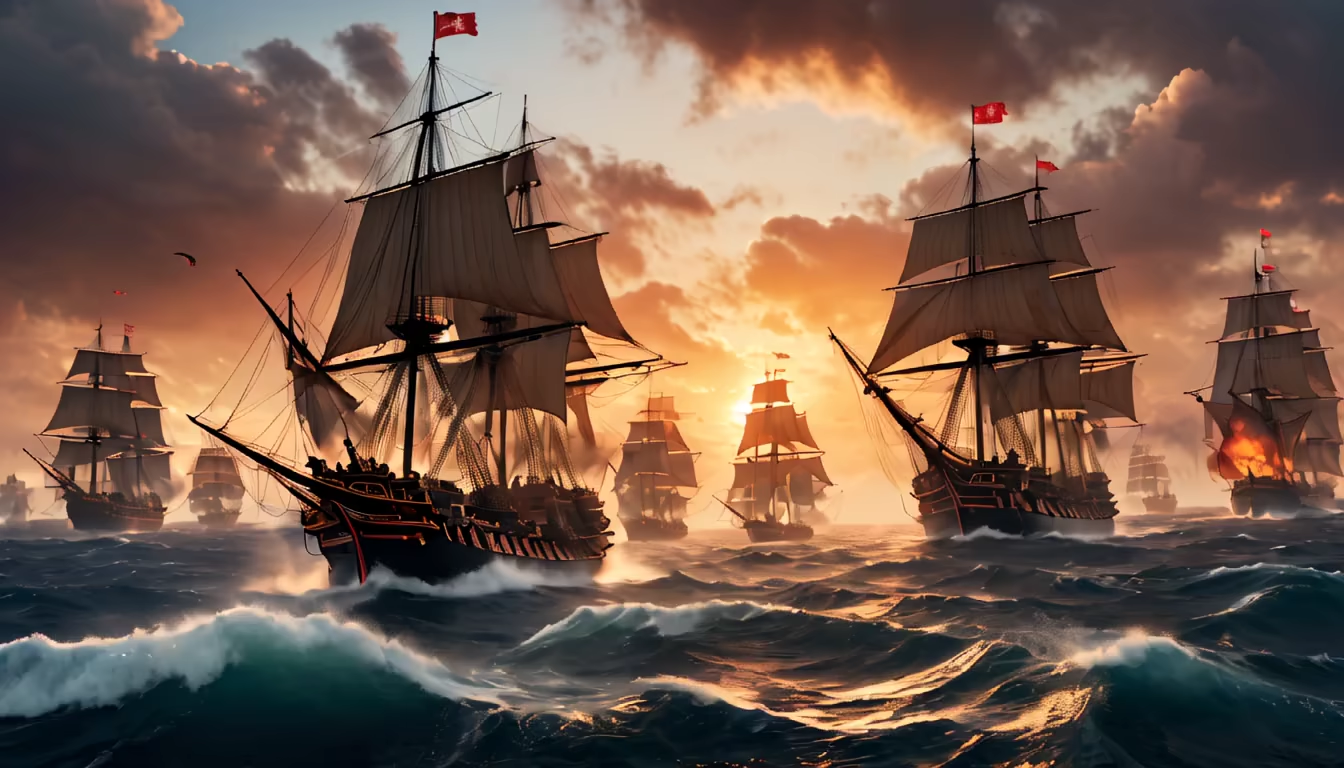
Prompt: \"Generate an immersive portrayal illustrating the shift caused by the treaty's requirement to open five treaty ports—Canton, Amoy, Foochow-fu, Ningpo, and Shanghai—showcasing the dissolution of China's former imperial control over foreign commerce and the ensuing influx of British trade and residency within these ports.\"
Style: Cinematic
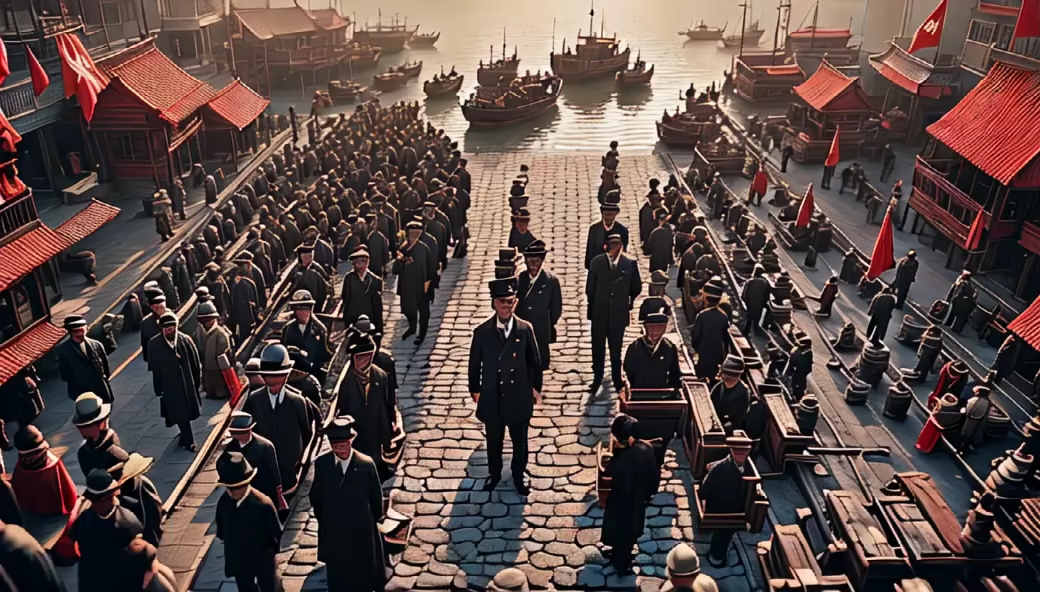
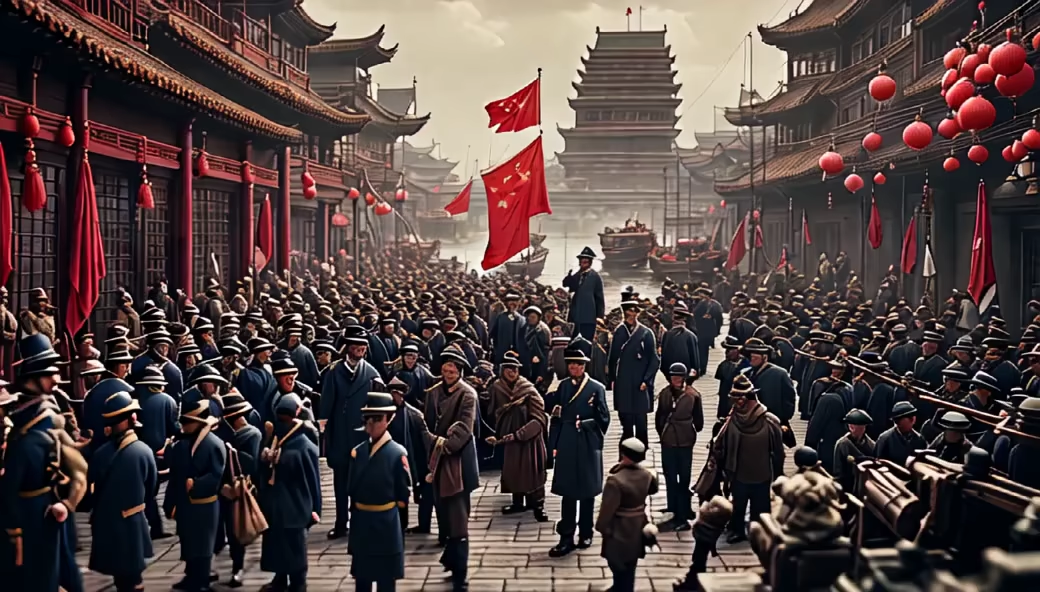
Prompt: a mermaid princess, in a coral reef, by Jasmine Becket-Griffith, by David Delamare, watercolor and acrylic, vibrant colors, fantasy art, DeviantArt, HD, underwater scene, bubbles and fish, sunlight rays, beautiful, magical


Prompt: An evocative visual portrays a dramatic maritime scene from the historical period of the Opium Wars. The image encapsulates the intensity of naval warfare during this time, showcasing a fierce confrontation between British and Chinese naval forces on the open sea. The foreground exhibits the tumultuous waters, roiled by the clash of warships, their sails taut against the wind. British war vessels, sleek and sturdy, engage in a strategic formation, cannons protruding from their sides, billowing smoke and fire as they exchange volleys with Chinese junks, adorned with colorful sails and intricate designs. The horizon is dominated by the vast expanse of the sea, with the sky painted in hues of orange and red from the setting sun, casting a fiery glow on the tumultuous scene. In the distance, the silhouettes of more ships approach, indicating the ongoing nature of the conflict and the continuous struggle for naval dominance. This image encapsulates the pivotal battles fought at sea during the Opium Wars, showcasing the high-stakes confrontations, technological disparities, and the crucial role of naval power in shaping the outcome of the conflicts between the British and Chinese forces.
Style: Cinematic
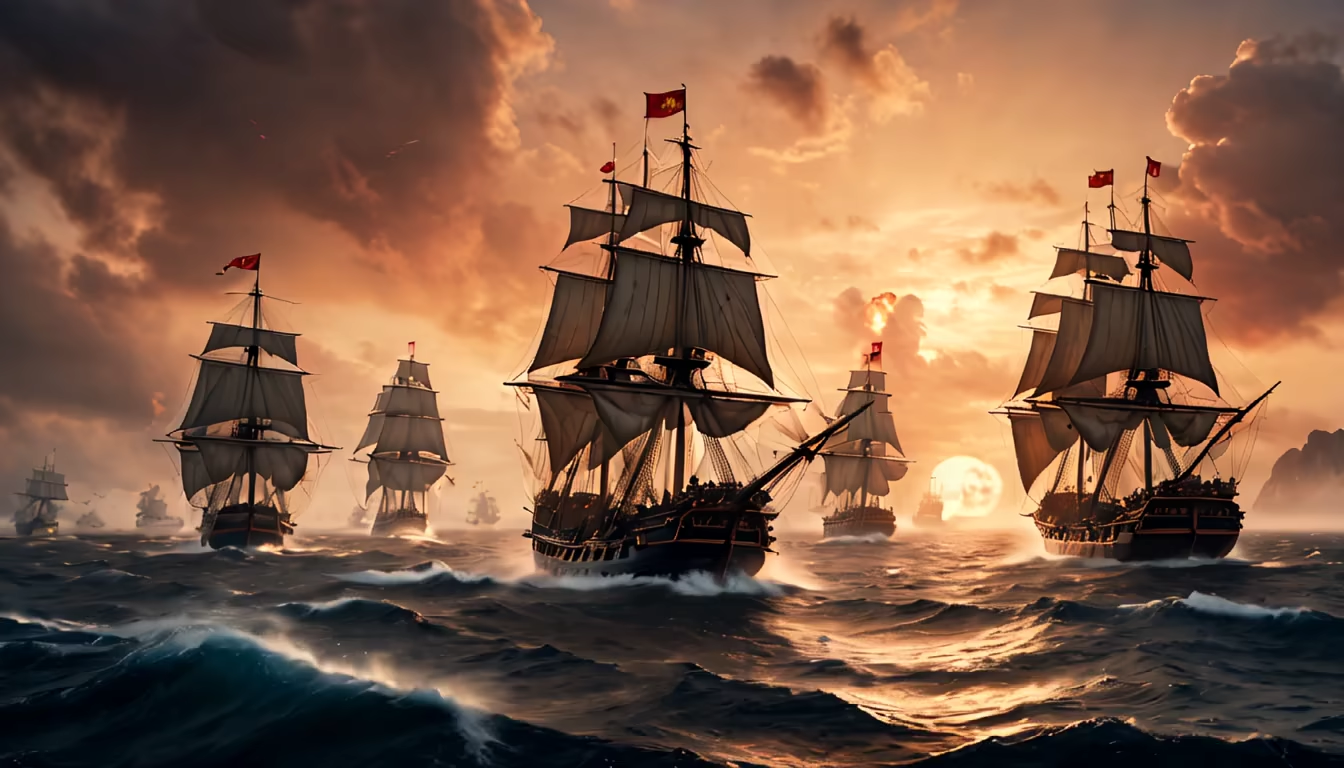
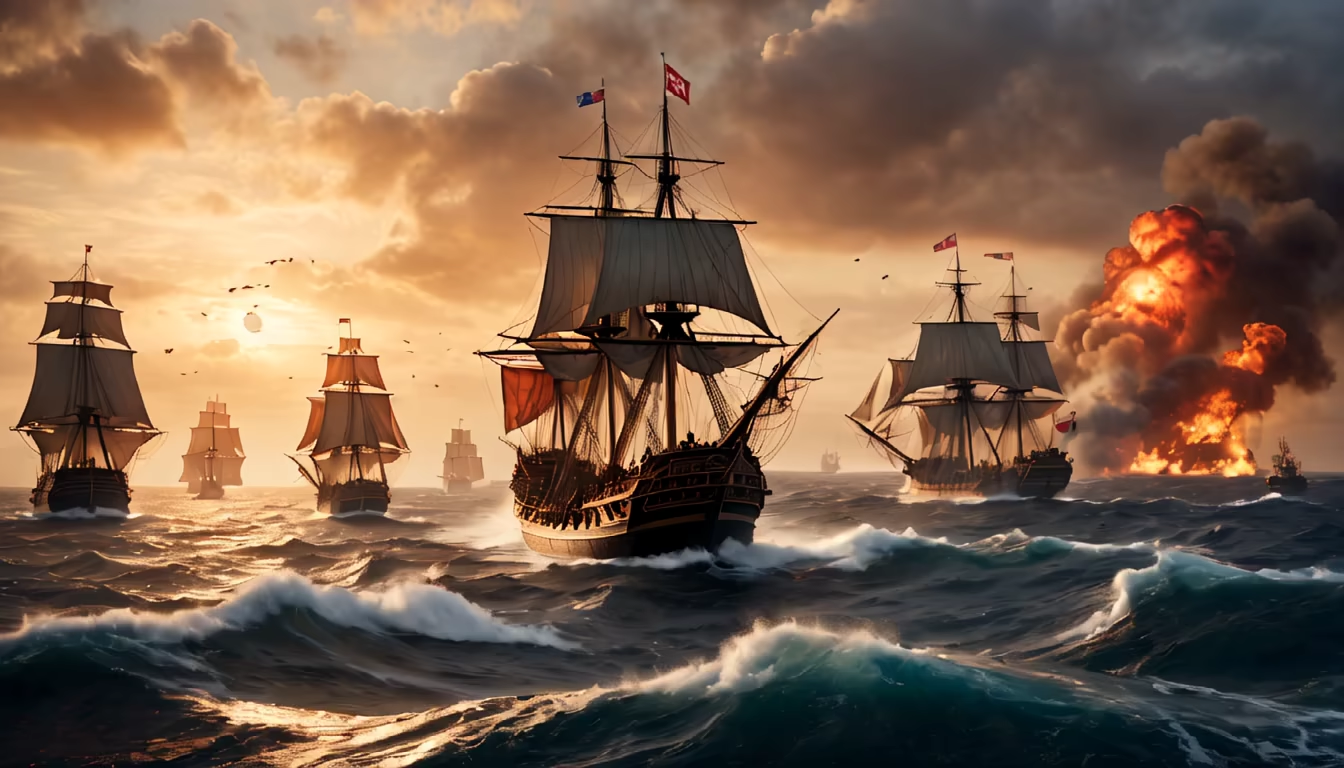
Prompt: Imagine an image split into two parts: one side representing Britain, with a depiction of powerful ships, possibly naval vessels or merchant ships, poised and ready, symbolizing Britain's military and economic might. On the other side, visualize China, featuring iconic elements like the Great Wall or a representation of Chinese authority, signifying the nation's historical strength and resilience.Between these two powerful visuals, illustrate a tense and charged atmosphere, perhaps with stormy skies or rising tension portrayed through subtle elements like soldiers lining up or representatives facing each other. This image aims to evoke a sense of imminent conflict and the monumental impact that the confrontation between Britain and China during this historical period would have on the world.
Style: Photographic
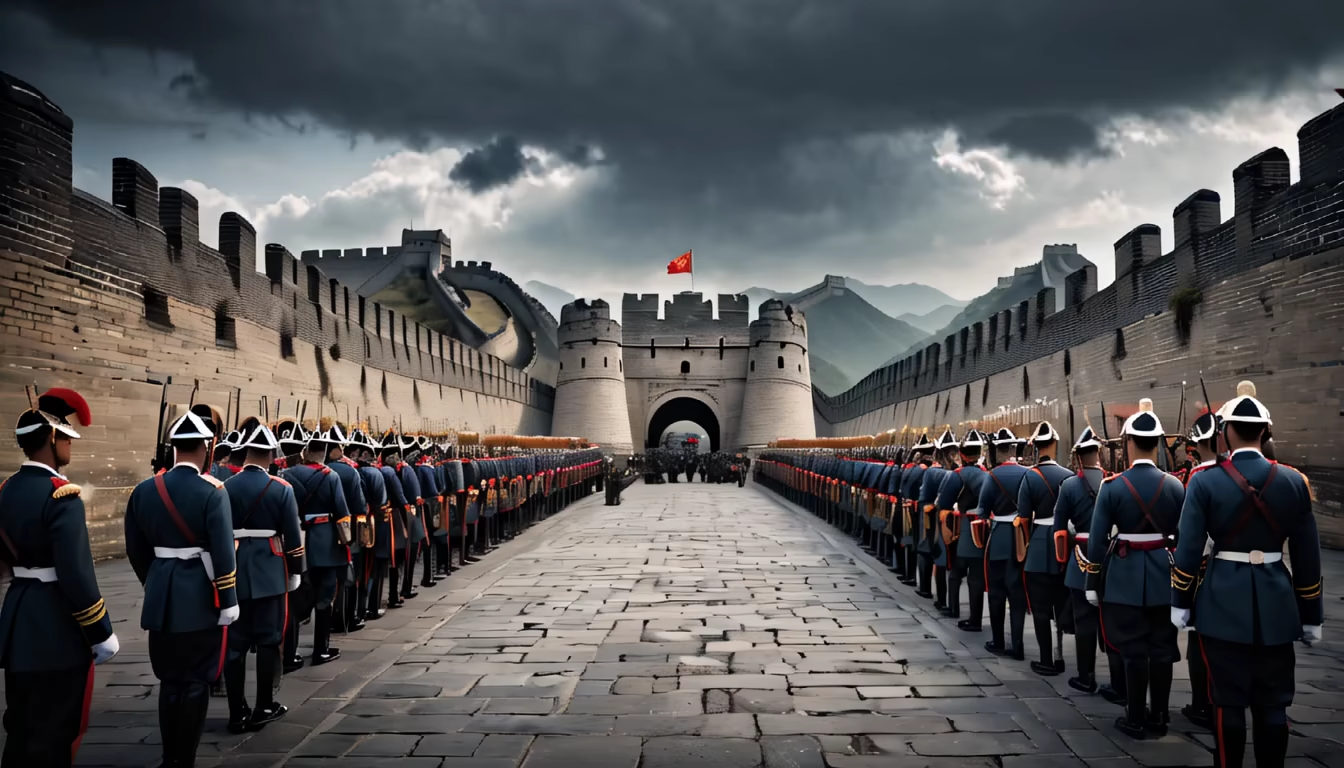

Prompt: Imagine an image split into two sections: one side depicting British ships on the waters near China, showcasing the naval strength and presence of the British Empire. On the other side, portray a representation of China, perhaps the coastline or iconic landmarks, depicting the country's sovereignty and historical significance.In the center, illustrate a brewing storm or intense atmosphere, symbolizing the escalating tensions between the two sides. Visual cues such as ships positioned for conflict or flags representing the nations involved can emphasize the building confrontation. This image aims to capture the pivotal moment in 1839 when escalating tensions culminated in the outbreak of the First Opium War, set against the backdrop of formidable naval forces and a historical clash of interests.
Style: Photographic
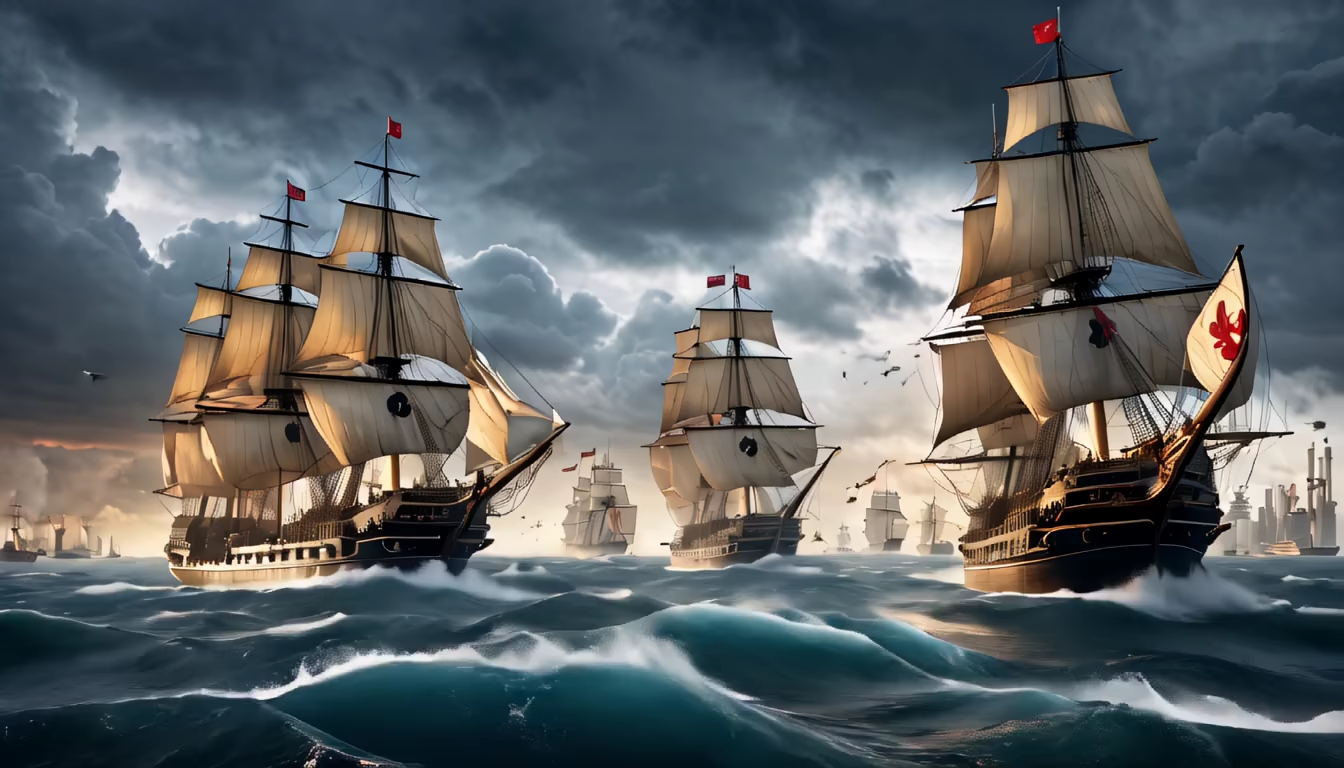

Prompt: showcasing the Chinese government's efforts to ban the opium trade, with officials destroying opium stocks and implementing anti-opium measures. This could be depicted through scenes of crackdowns on opium dens or the destruction of confiscated opium.
Style: Photographic


Prompt: in the style of marvel‘s what if series, Captain America blocking gunshots with his shield over at night, Marvel Animation style




Prompt: The scene is set against the backdrop of a bustling port city in the early 19th century. On the left side of the image, Chinese merchants are depicted, dressed in traditional silk robes, overseeing the loading and unloading of goods from junks (Chinese sailing ships). The atmosphere is vibrant with activity as workers carry chests of tea, porcelain, and silk, showcasing China's rich cultural and trade heritage. On the right side of the image, British traders and soldiers are shown. The British are clad in their military uniforms, overseeing the loading of opium crates onto their ships. These vessels are imposing and bear the Union Jack, signifying the power and reach of the British Empire. The British traders are depicted negotiating with Chinese officials, highlighting the tension and power dynamics arising from the trade of opium, a lucrative commodity sought by the British but condemned by the Chinese government. In the center of the image, there is a symbolic divide marked by a river or a stretch of water, symbolizing the cultural, economic, and ideological gulf between the two sides. The contrast between the traditional Chinese setting and the modern British presence represents the clash of civilizations and values that characterized the First Opium War. The sky above the scene is cloudy, hinting at the looming conflict and the turbulent times ahead. Smoke billows in the distance, foreshadowing the destructive consequences and lasting impact that this war would have on history. Overall, the image captures the dichotomy between tradition and modernity, East and West, trade and conflict that defined the First Opium War and its significance in shaping the pages of history.
Style: Photographic
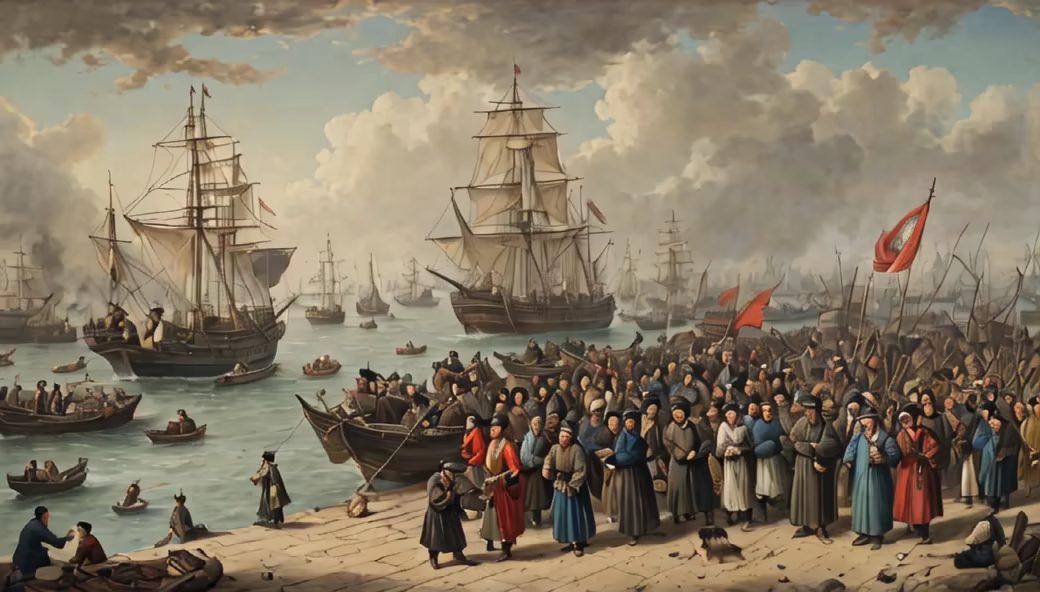
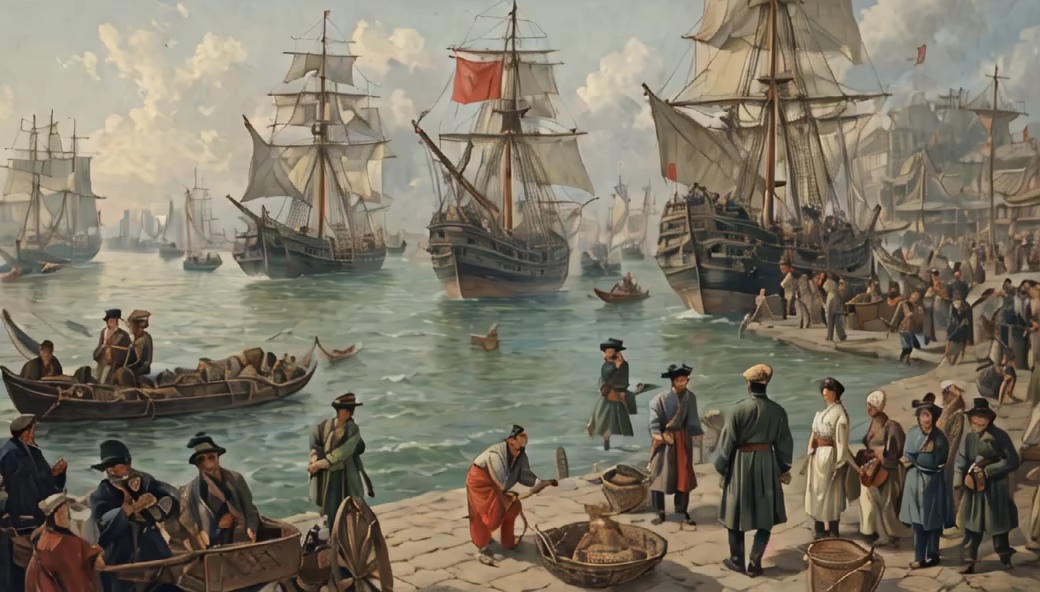
Prompt: \"After the destruction of their opium, the British, fueled by indignation, pressed for compensation and adamantly asserted the necessity of upholding the trade, marking a pivotal moment in the diplomatic tension between the nations.\"
Style: Photographic


Prompt: \"After the destruction of their opium, the British, fueled by indignation, pressed for compensation and adamantly asserted the necessity of upholding the trade, marking a pivotal moment in the diplomatic tension between the nations.\"
Style: Photographic


Prompt: Visualize the concept of extraterritoriality with two scales - one side representing British law and the other Chinese law, with a British citizen standing elevated on the British law side, symbolizing the legal superiority granted by the treaty. ancient background .ancient british \u0026 chinese people should be shown . two pictures should be shown in one frame depicting the situation .
Style: Cinematic
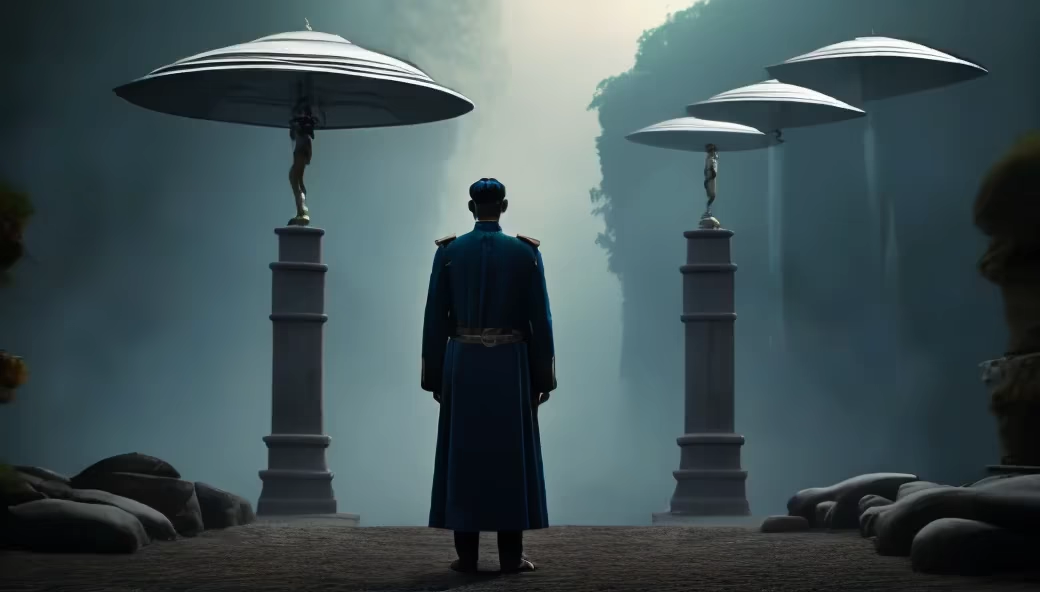

Prompt: Imagine an image focused on Commissioner Lin Zexu, depicted as a determined figure, possibly in traditional attire, standing prominently in a position of authority. Surround him with scrolls or texts, symbolizing his legal and moral stance against the opium trade. He could be portrayed either overseeing the destruction of opium or engaged in discussions with officials, emphasizing his strong opposition to the trade.In the background, you might illustrate scenes of the opium trade or British merchants to create a contrast between Lin Zexu's anti-opium stance and the context of the prevalent trade. The image should capture the essence of Lin Zexu's unwavering dedication to combating the opium trade, showcasing his pivotal role in this historical conflict.
Style: Photographic
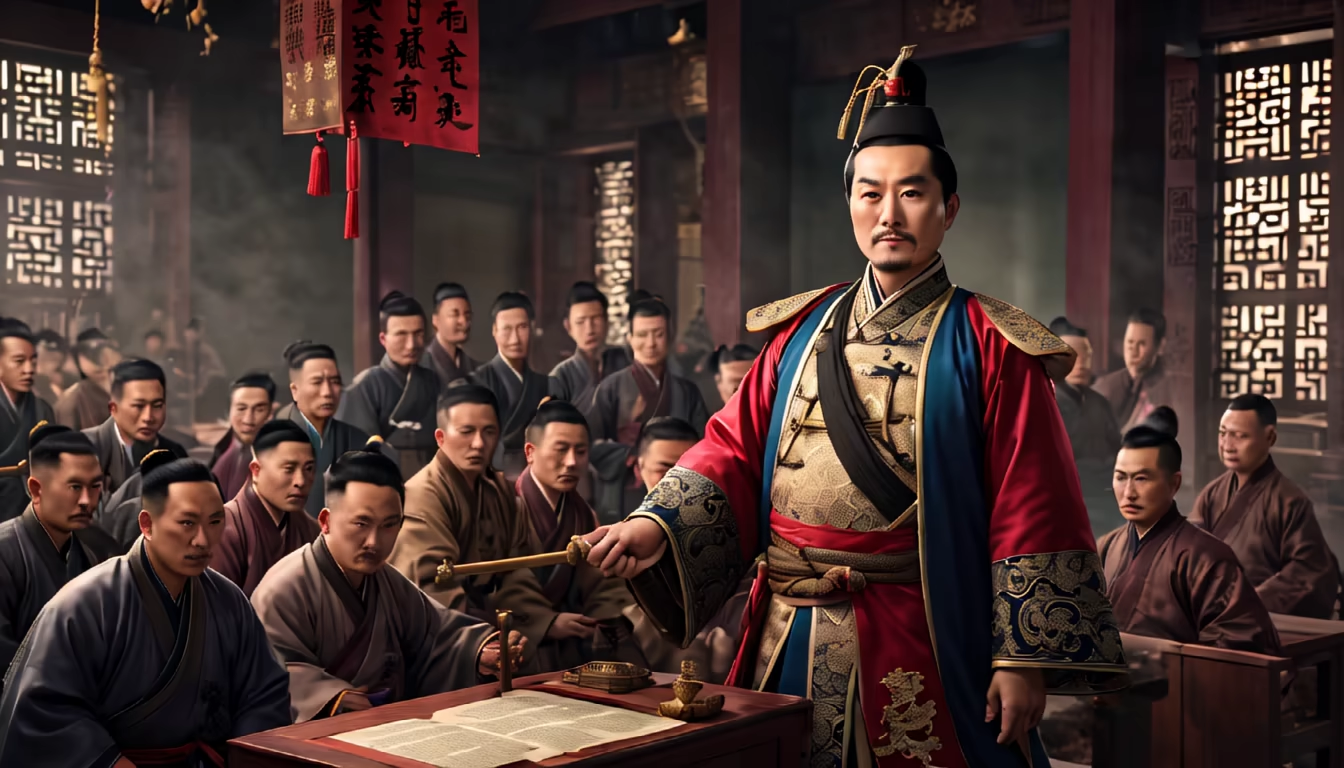
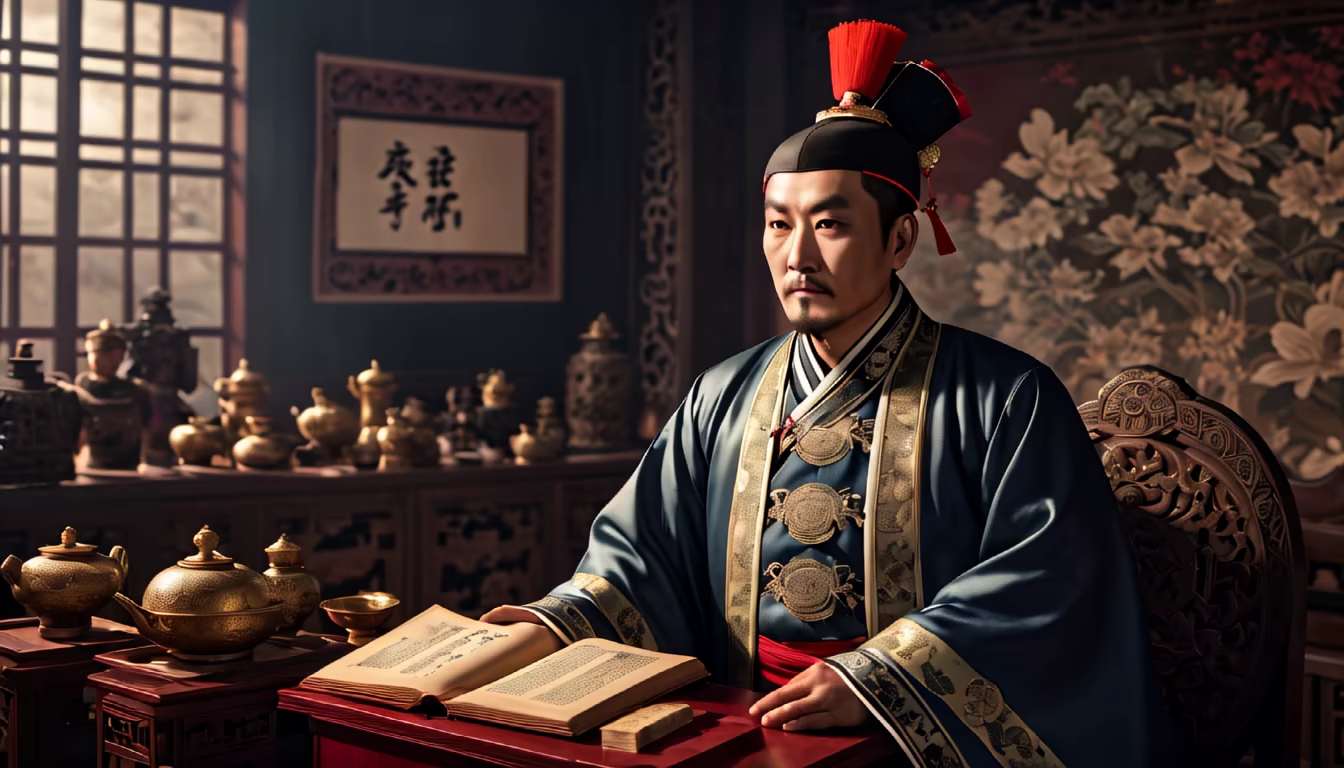
Prompt: A vivid, bustling scene depicting the vibrant landscape of Guangdong Province in the 19th century. The image captures the essence of the province, showcasing a bustling harbor teeming with numerous ships from various nations, their sails billowing in the breeze. On the docks, a fusion of cultures is evident as merchants from China and Western countries engage in animated discussions and trade activities. Amidst the commotion, opium chests are being unloaded from a British ship, flanked by Chinese officials and traders engaged in heated discussions. In the background, traditional Chinese architecture dots the landscape, juxtaposed against the imposing presence of Western-style buildings, symbolizing the clash of cultures and interests. Smoke wafts from opium dens nestled along narrow alleys, hinting at the pervasive influence of the opium trade within the province. The atmosphere is a blend of dynamism and tension, portraying the complex interactions, conflicts, and power struggles that characterized Guangdong Province as the epicenter of the opium trade during this era.
Style: Photographic
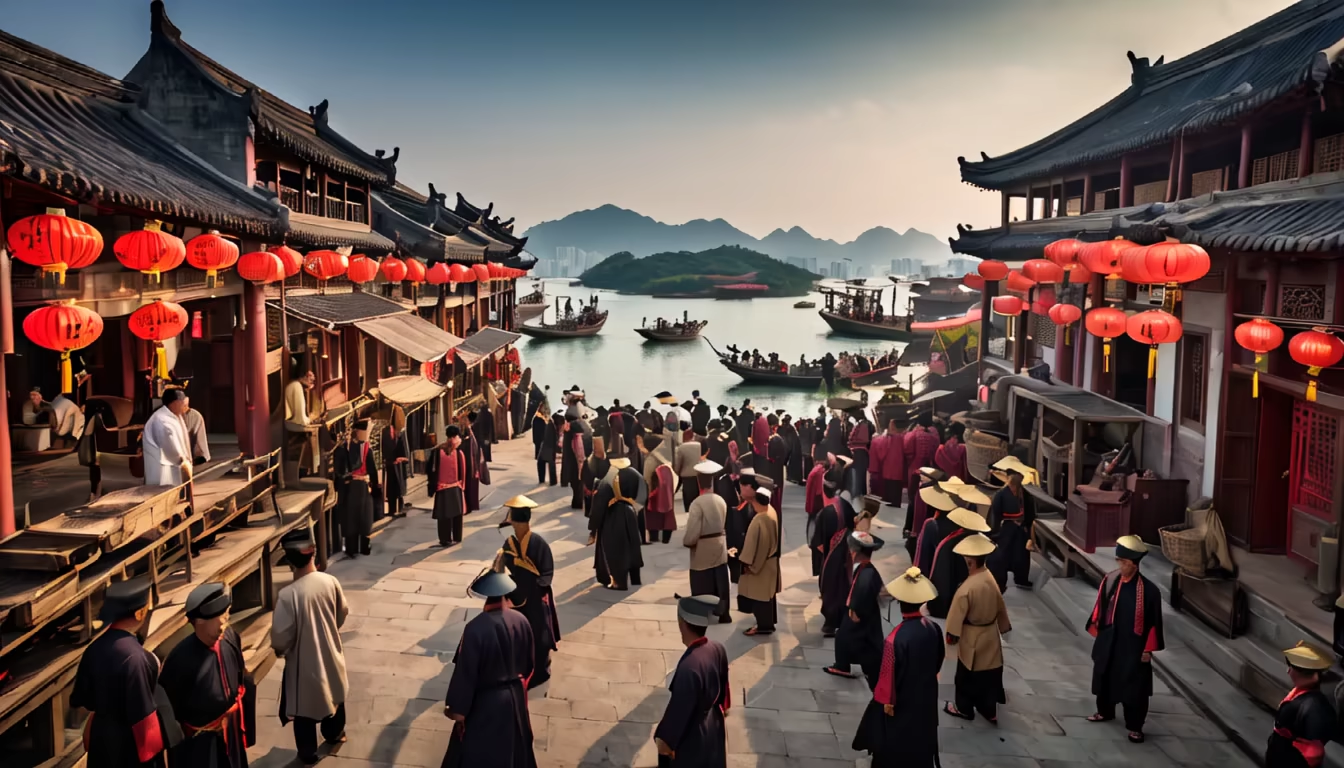
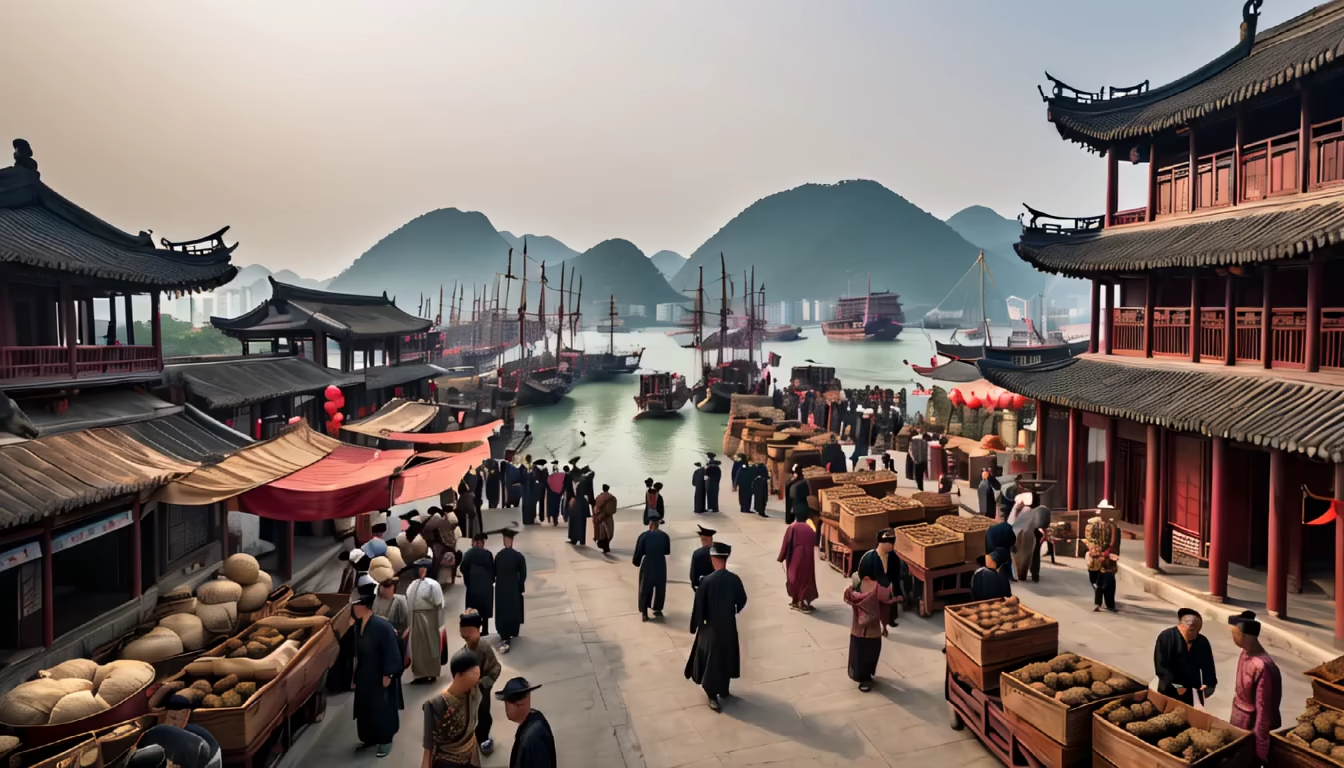
Prompt: The setting is a battlefield during the Opium War. On one side, British troops are seen advancing with cannons and rifles, their artillery pounding the defensive structures of the Chinese. Smoke billows from the Chinese defenses, showing signs of collapsing under the relentless assault. Amidst the chaos, the devastation caused by modern weaponry is evident. In the background, trade ships symbolize the economic motives behind the conflict, highlighting the repercussions of misguided trade policies that led to this destructive war.
Style: Cinematic

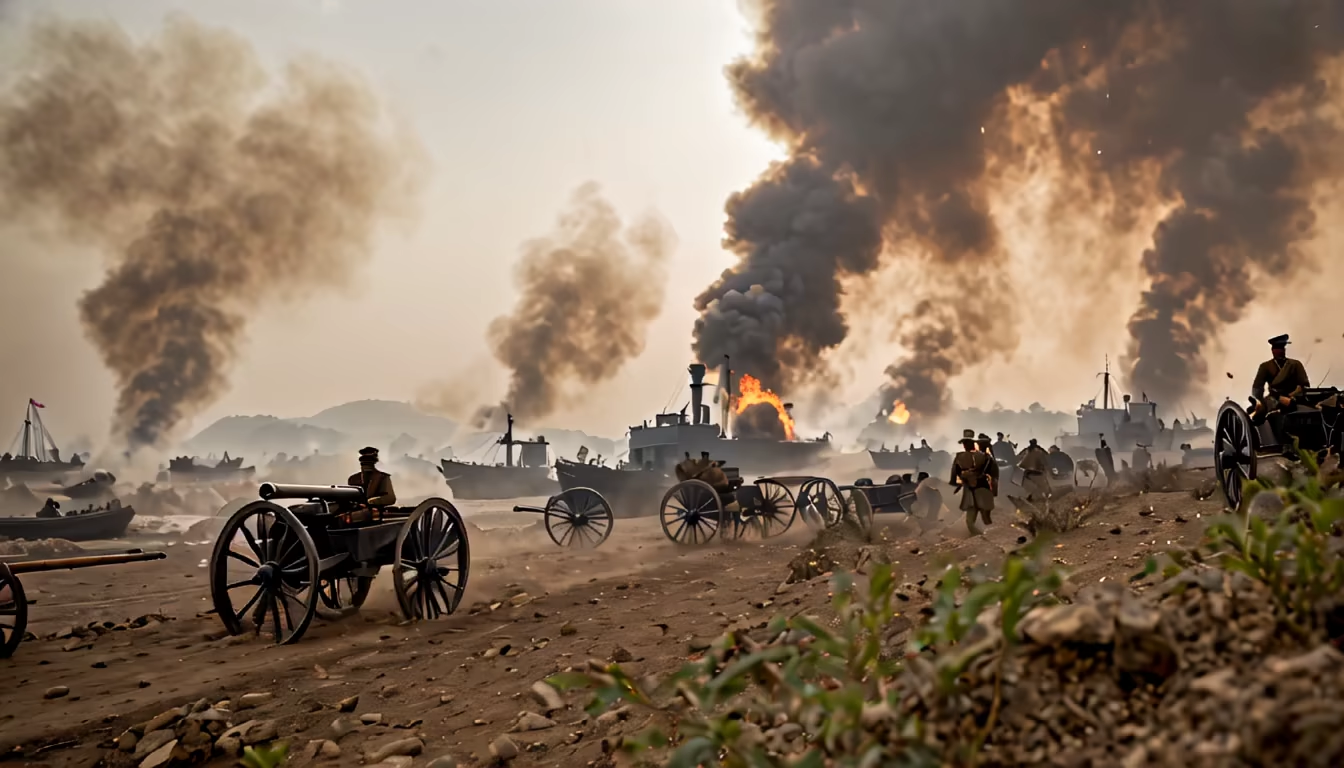
Prompt: The setting is a battlefield during the Opium War. On one side, British troops are seen advancing with cannons and rifles, their artillery pounding the defensive structures of the Chinese. Smoke billows from the Chinese defenses, showing signs of collapsing under the relentless assault. Amidst the chaos, the devastation caused by modern weaponry is evident. In the background, trade ships symbolize the economic motives behind the conflict, highlighting the repercussions of misguided trade policies that led to this destructive war.
Style: Photographic

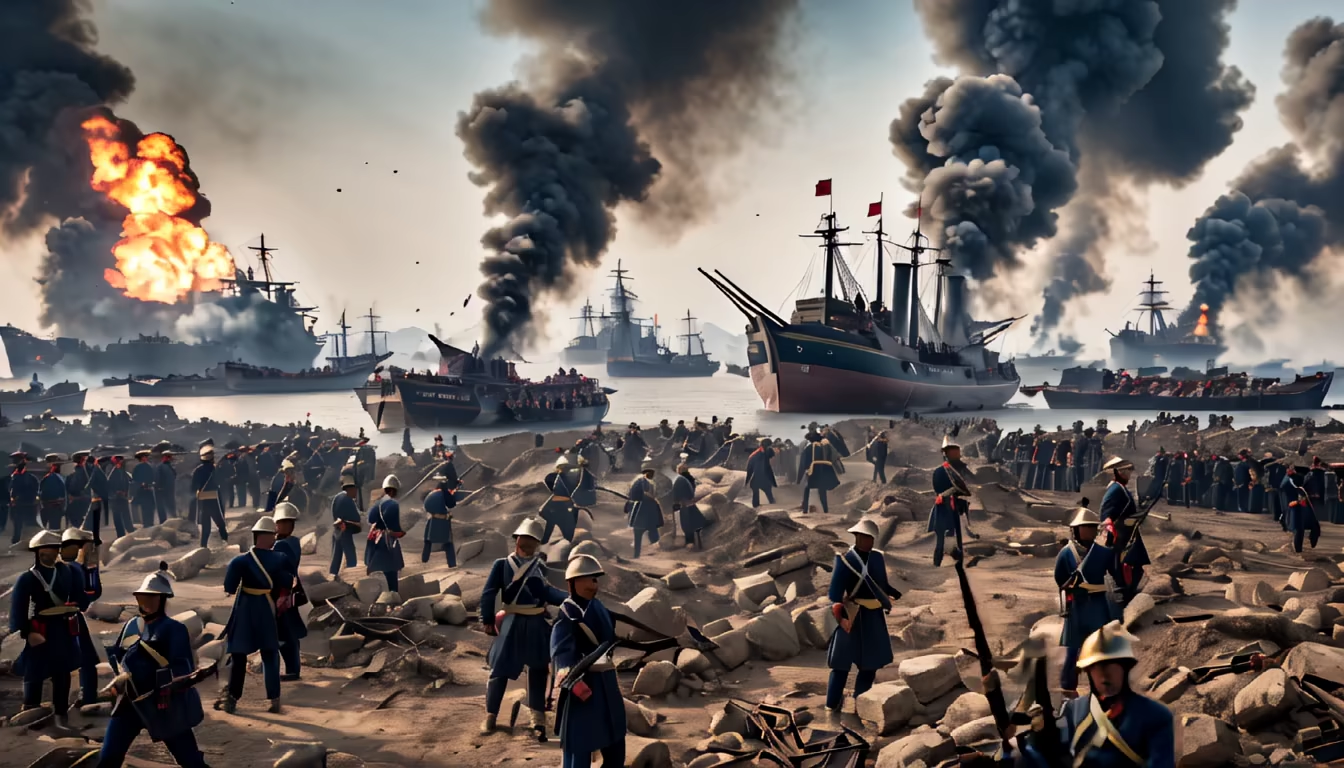
Prompt: Set against a backdrop of the bustling Victoria Harbour, a historic ceremony unfolds. Representatives from Qing China and the British Empire stand on opposite sides of a grand table adorned with maps and documents. With a backdrop of ornate silk banners, the pivotal moment arrives—the handing over of this lush island(HONG KONG) to the British Empire. A sense of anticipation and uncertainty hangs in the air, marking the beginning of an era that will shape Hong Kong's destiny and its complex intermingling of cultures and histories. THE BACKDROP SHOULD BE DURING THE OPIUM WAR . THIS EVENT OCCURED IN 1842 .
Style: Photographic
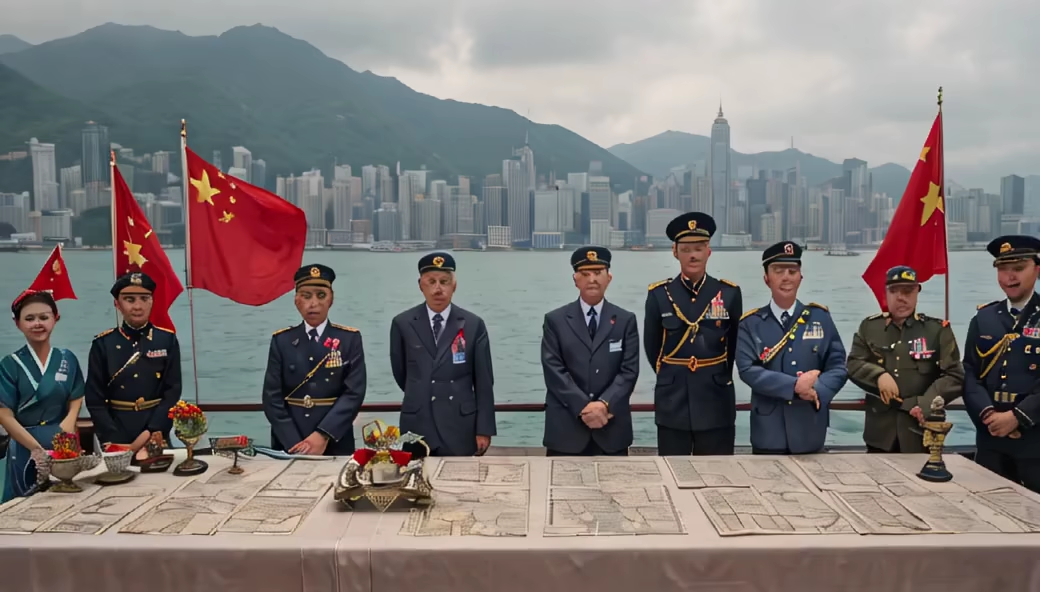

Prompt: During the Opium War , imagine a scene with British troops advancing amidst the chaos of battle, with Chinese soldiers retreating, their fortifications crumbling. Smoke and destruction litter the landscape, emphasizing the impact of modern weaponry. In the background, perhaps trade ships symbolize the underlying economic tensions that fueled the conflict.
Style: Photographic
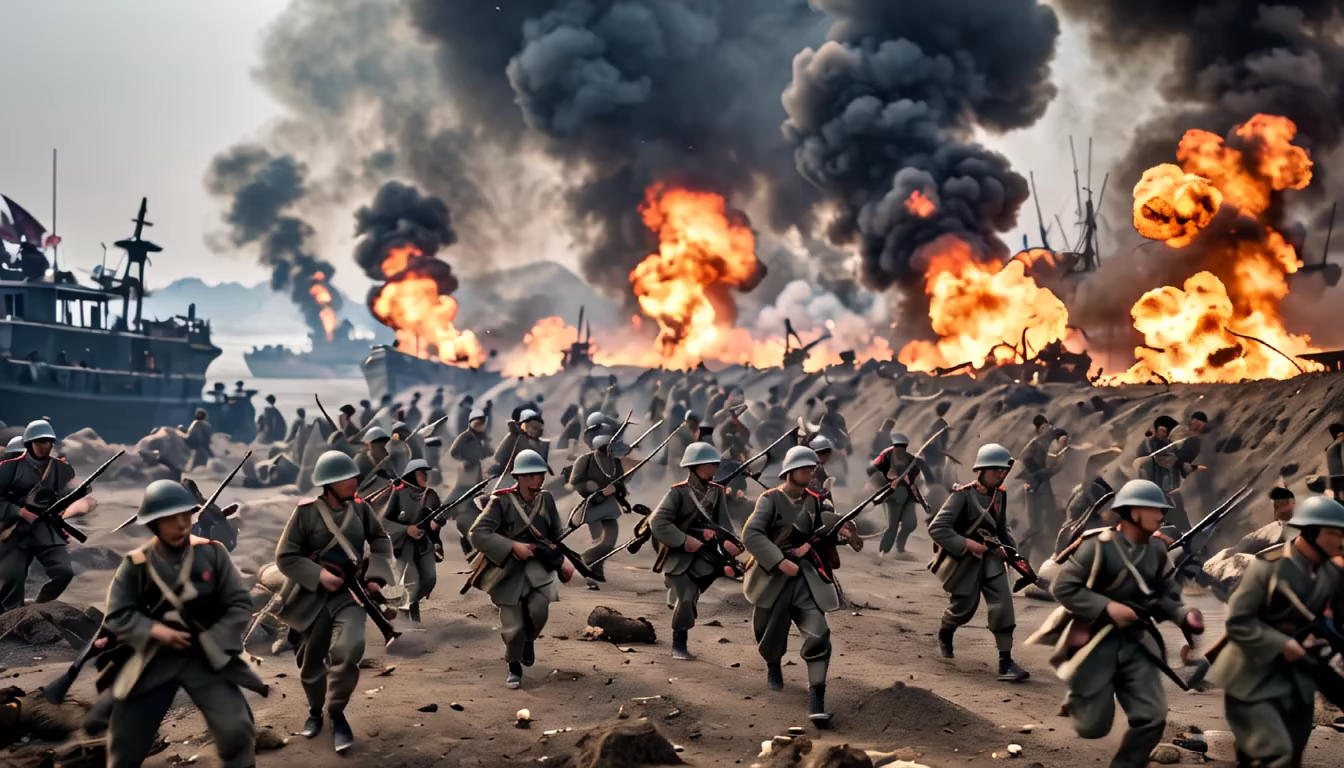
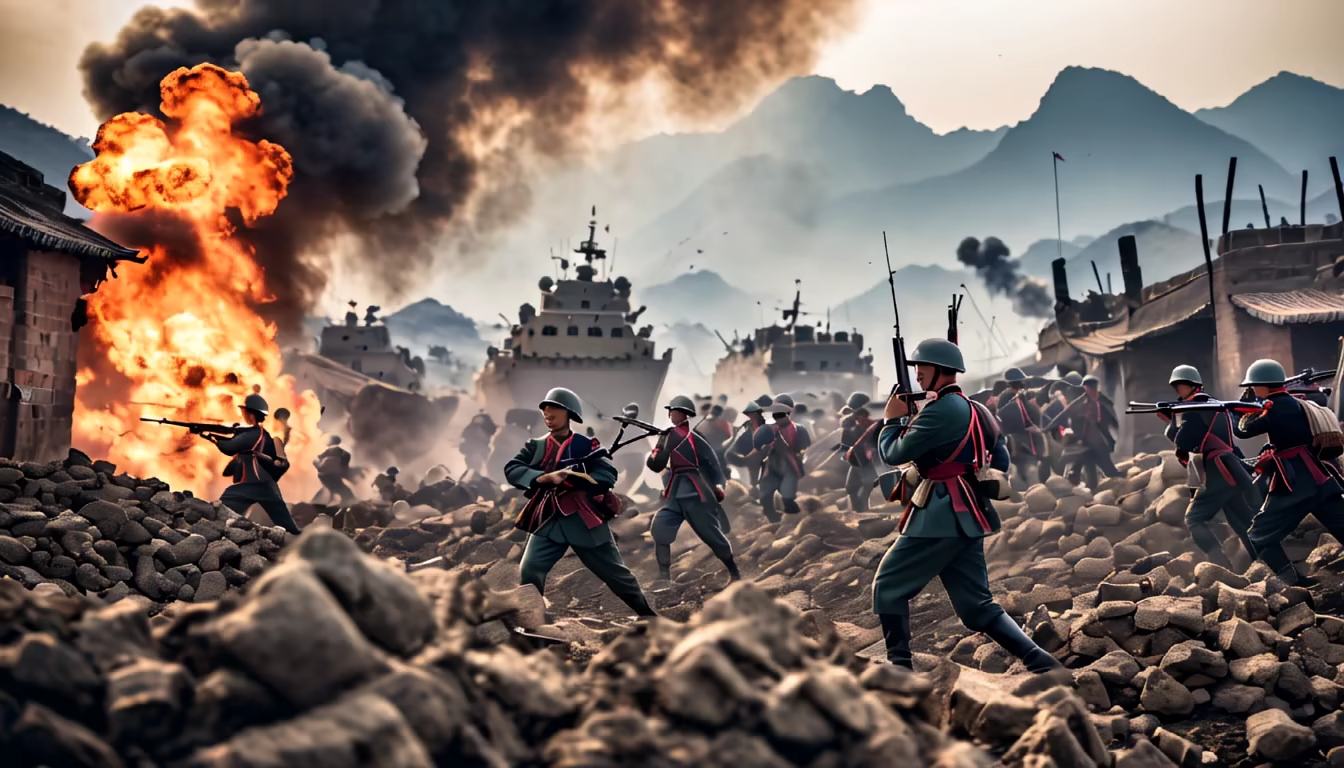
Prompt: Showcasing three distinct scenes - Tamao, Chuanbi, and Bogue - each with British naval ships dominating the waters. Highlight the British fleet's overwhelming firepower and strategic positioning, exerting control over crucial waterways. The scene depicts the impact on Chinese trade routes and military, portraying the pressure and consequences of British naval dominance during these historic battles.
Style: Photographic
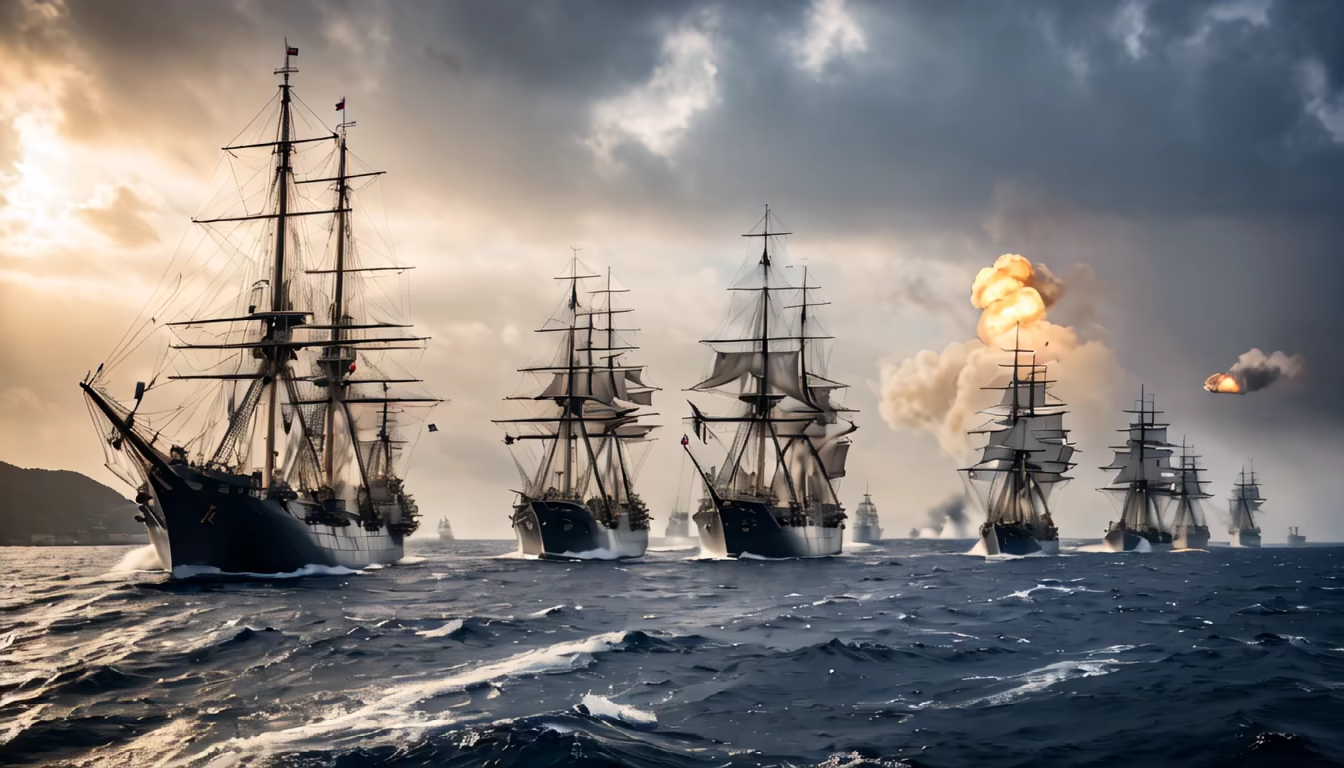
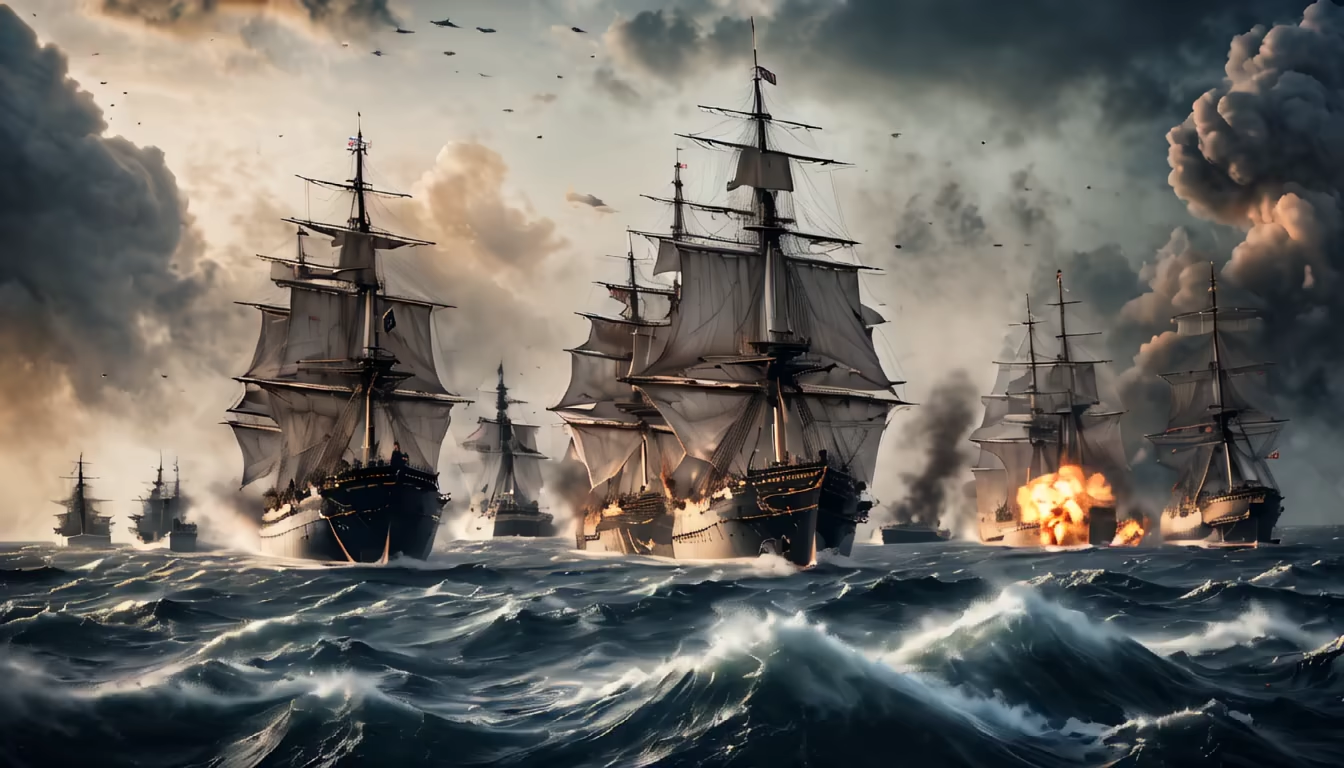
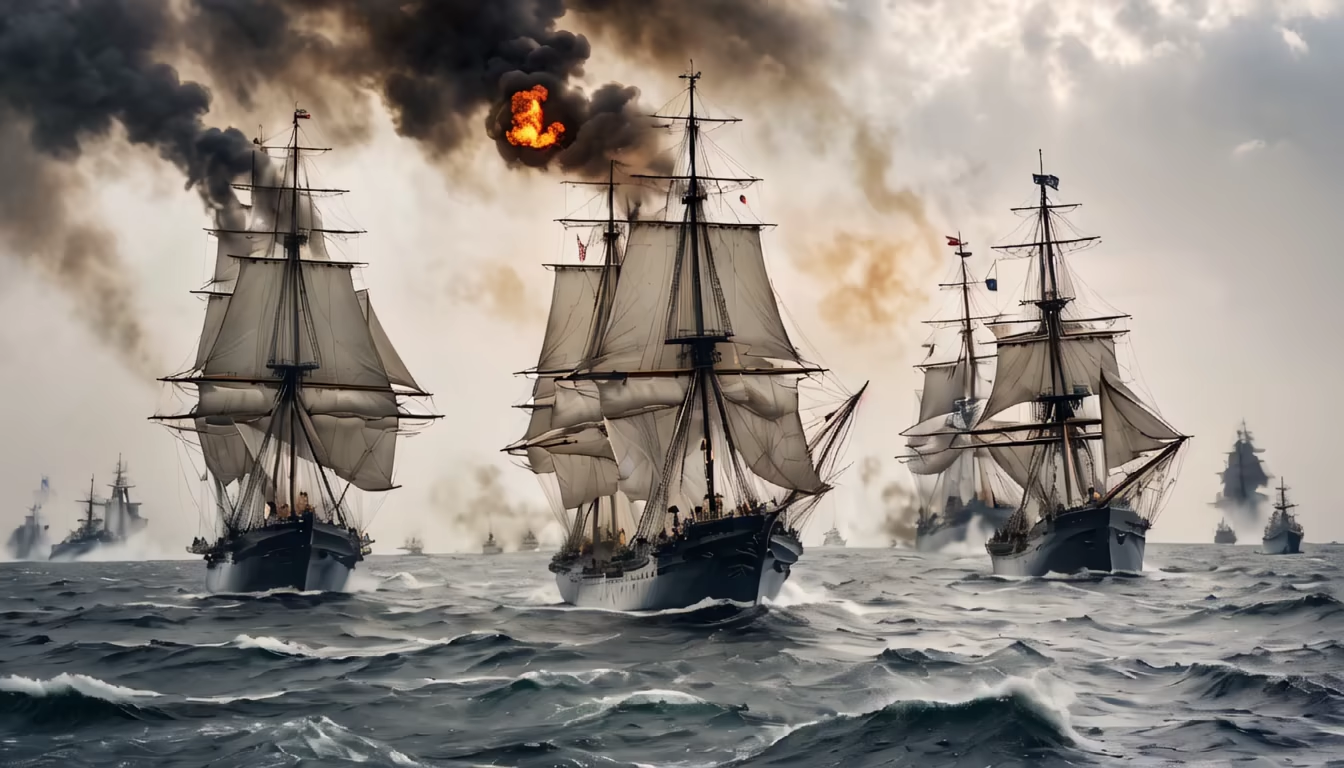

Prompt: The image depicts a stylized representation of a historical scene from the First Opium War. In the foreground, there are silhouettes of British and Chinese ships engaged in conflict, with billowing smoke from cannon fire. The British ships, appearing more modern and technologically advanced, loom prominently, while the Chinese vessels are depicted with a sense of struggle and vulnerability. Amidst the chaos, there are symbolic elements scattered around: broken treaties, opium crates, trade agreements, and people suffering in the background, hinting at the destructive aftermath of the conflict. The image aims to portray the clash between advanced weaponry, misguided trade policies, and the human cost of such conflicts, evoking a sense of turmoil and consequence.
Style: Photographic
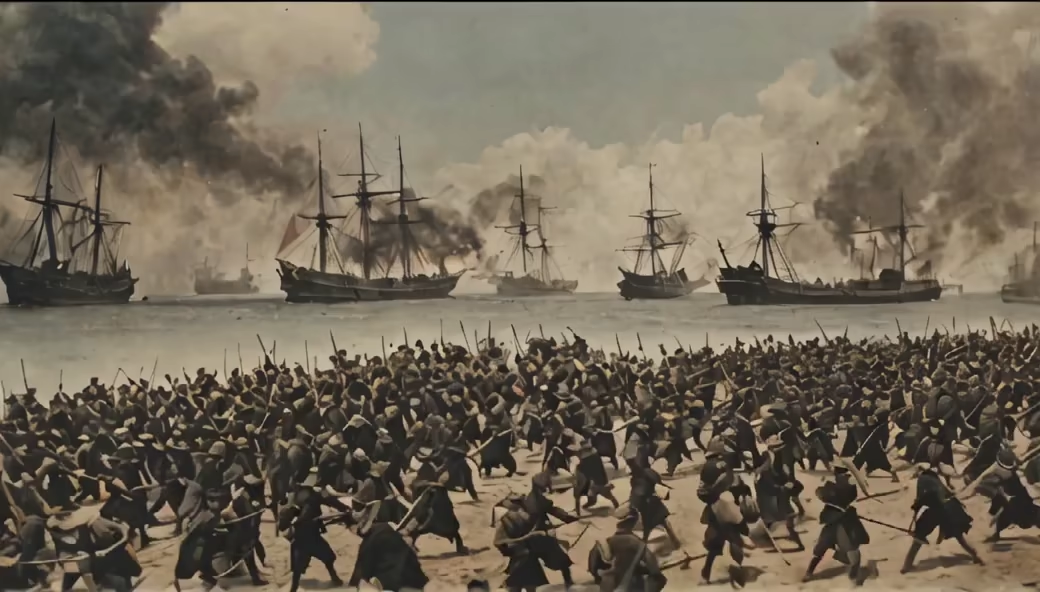
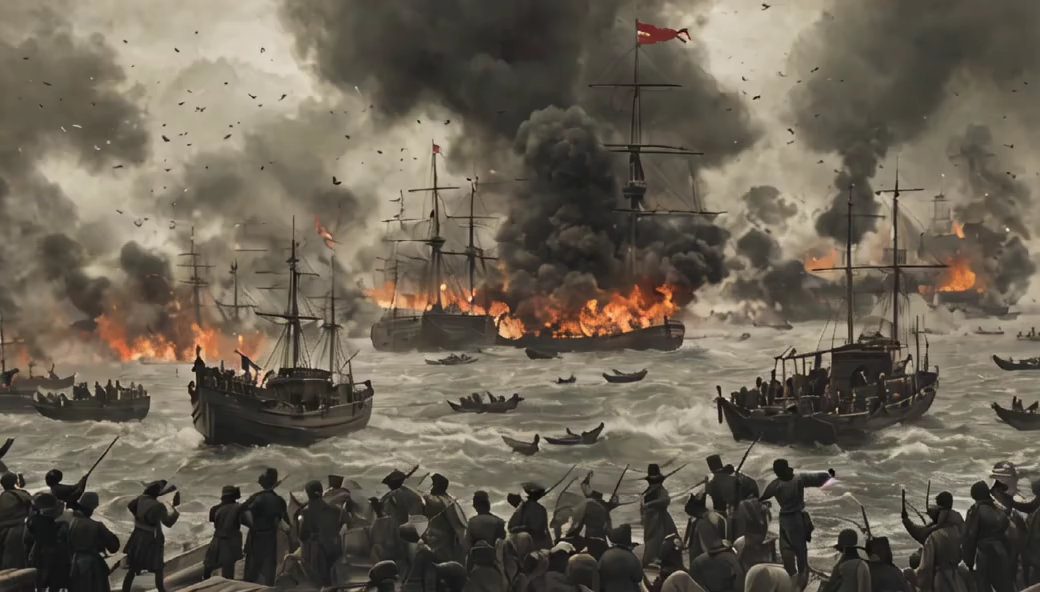
Prompt: Generate an evocative visual representation depicting the enforced opening of the five treaty ports - Canton, Amoy, Foochow-fu, Ningpo, and Shanghai - showcasing the significant shift from the prior imperial control over foreign commerce to the initiation of British trade and habitation within these ports as mandated by the treaty.
Style: Cinematic
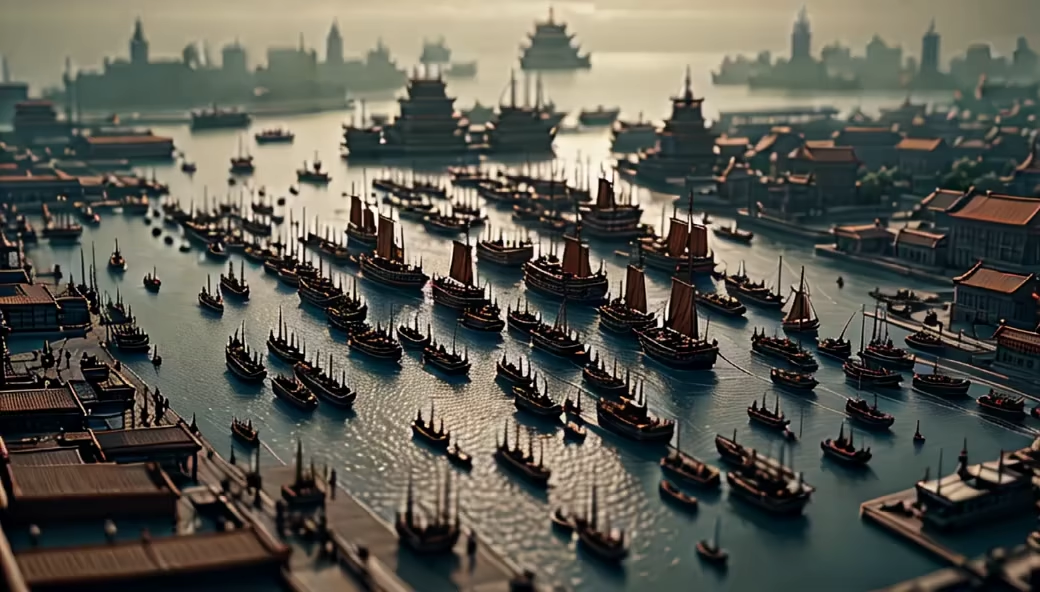

Prompt: \"Craft an image that symbolizes the transformative impact of the treaty's mandate to open five pivotal treaty ports - Canton, Amoy, Foochow-fu, Ningpo, and Shanghai - depicting the dissolution of the former imperial monopoly on foreign commerce and the emergence of British trade and residence within these ports.\"
Style: Cinematic
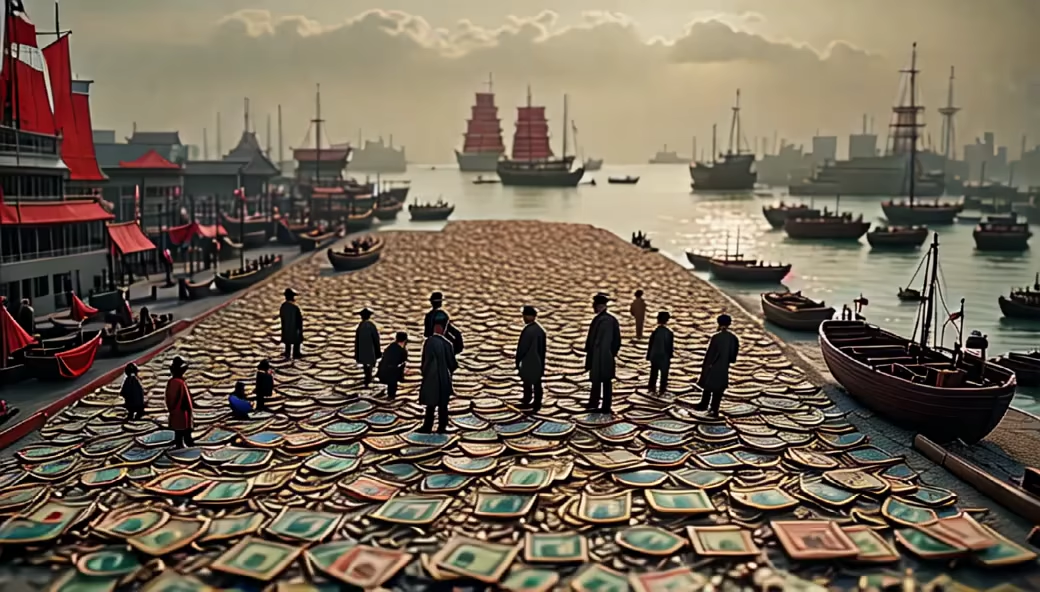
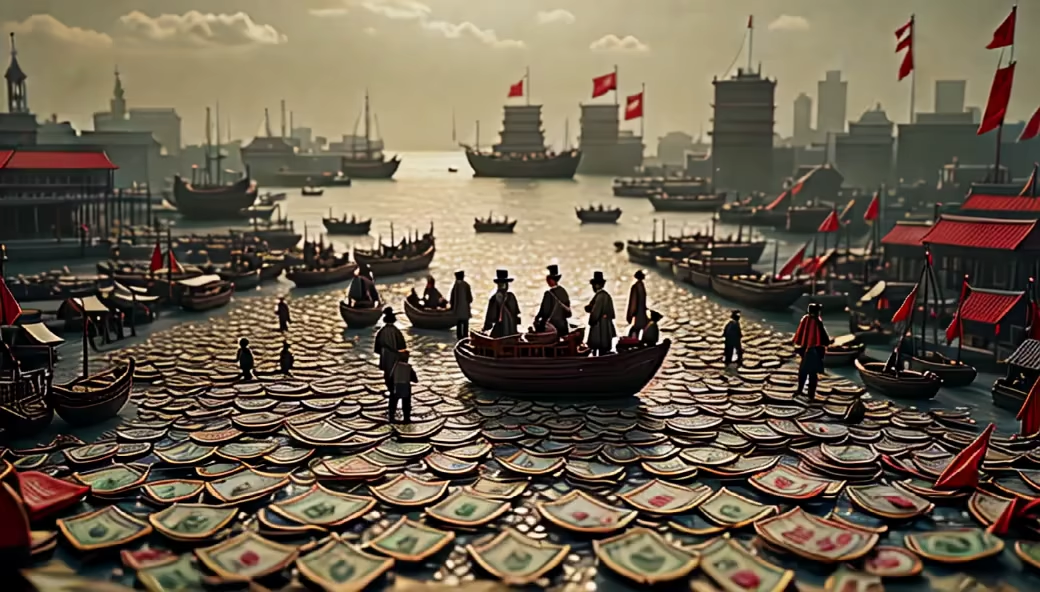
Prompt: \"Craft an image that symbolizes the transformative impact of the treaty's mandate to open five pivotal treaty ports - Canton, Amoy, Foochow-fu, Ningpo, and Shanghai - depicting the dissolution of the former imperial monopoly on foreign commerce and the emergence of British trade and residence within these ports.\"
Style: Cinematic
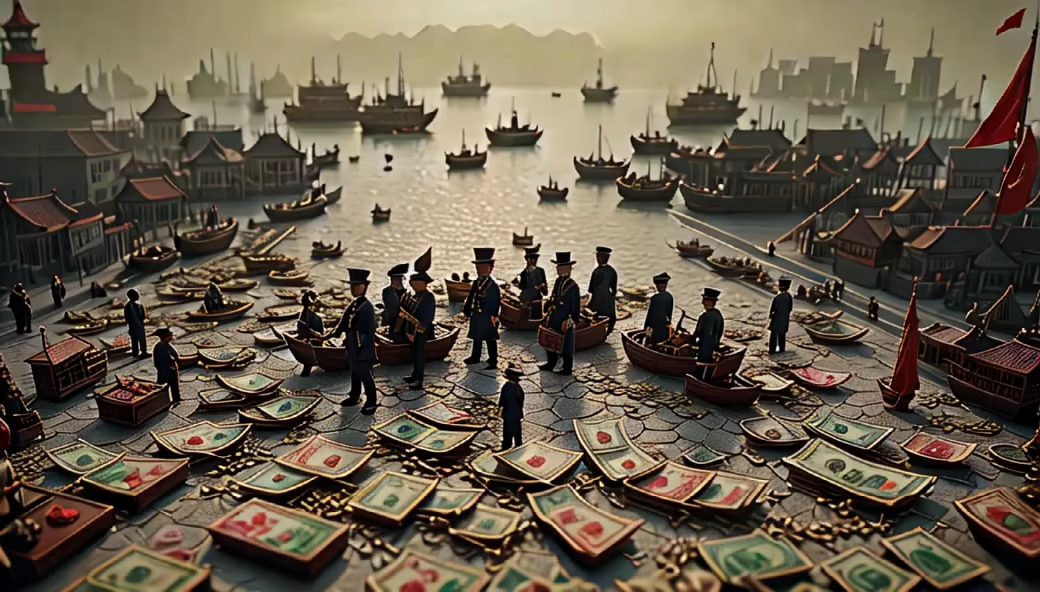
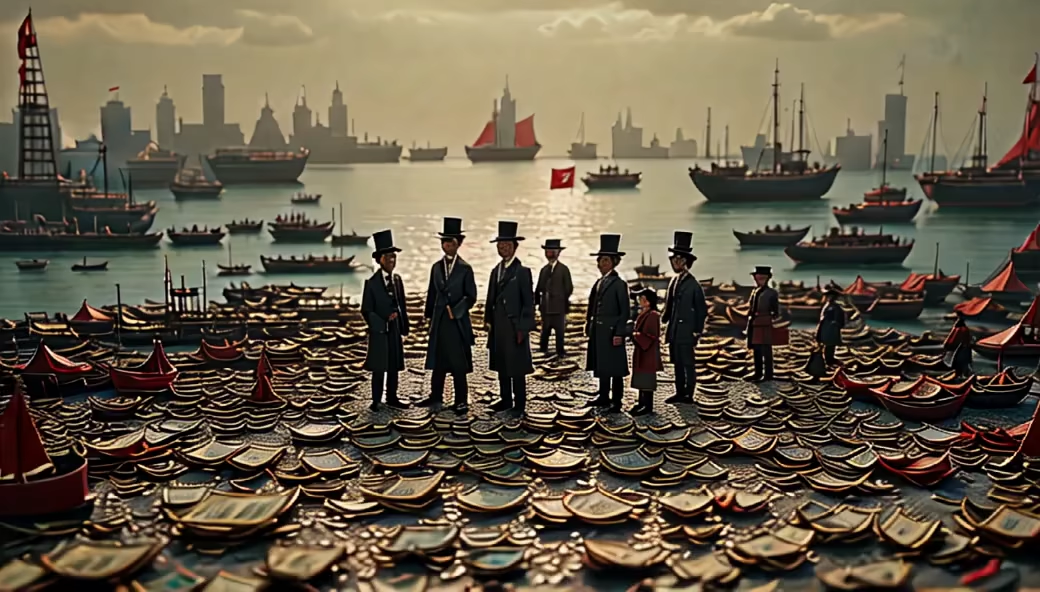
Prompt: The image depicts a scene of sorrow and despair in China during the Opium War era. Chinese civilians are shown in disarray, some mourning, while others gaze in dismay at the destruction around them. In the background, British forces loom, their modern weaponry and imposing presence symbolizing the overwhelming power that led to the \"Century of Humiliation.\" The image encapsulates the shattered pride and vulnerability of the Chinese nation during this period of turmoil caused by misguided trade policies and devastating warfare.
Style: 3D Model
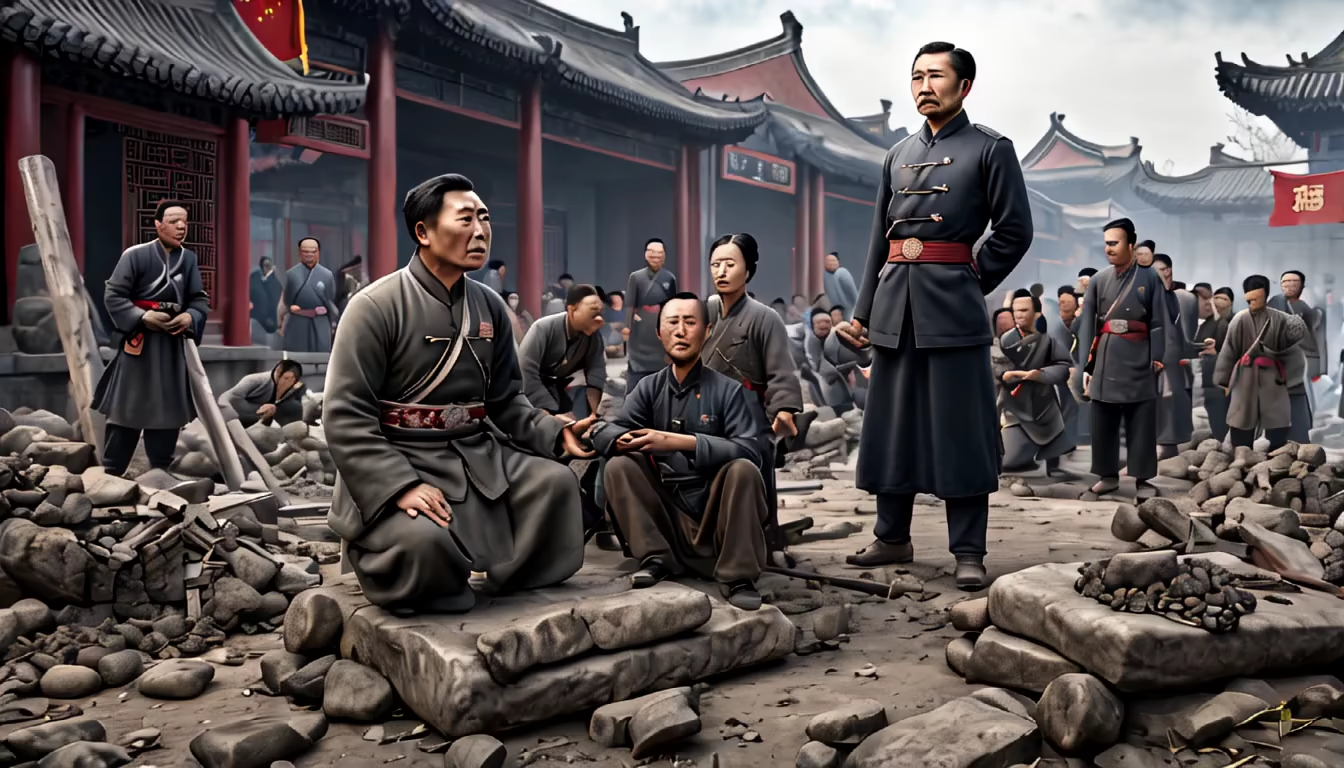

Prompt: \"In the face of refusal, the British, staunch in their stance, demanded recompense for the lost opium and the preservation of trade. Upon encountering resistance, their formidable naval forces embarked on a determined course toward the shores of China, signaling an impending clash of powers.\"
Style: Photographic
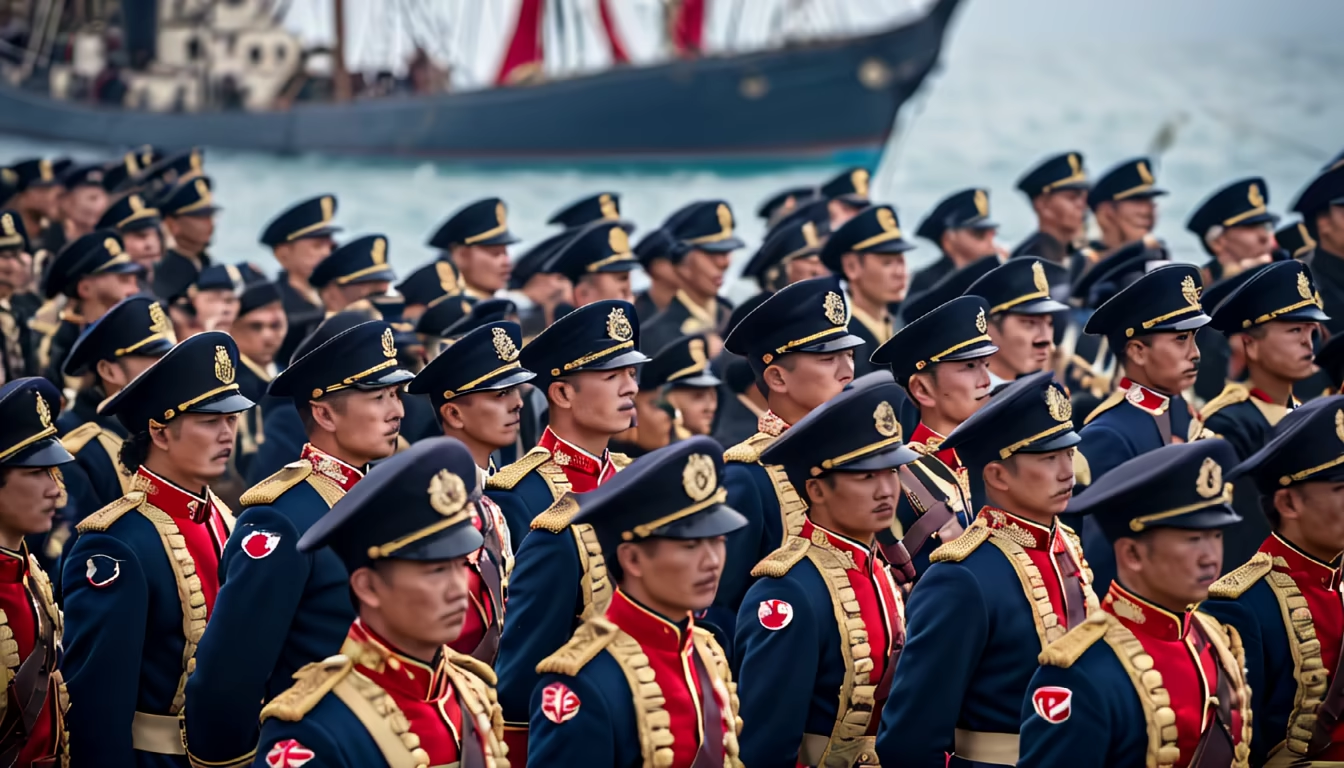
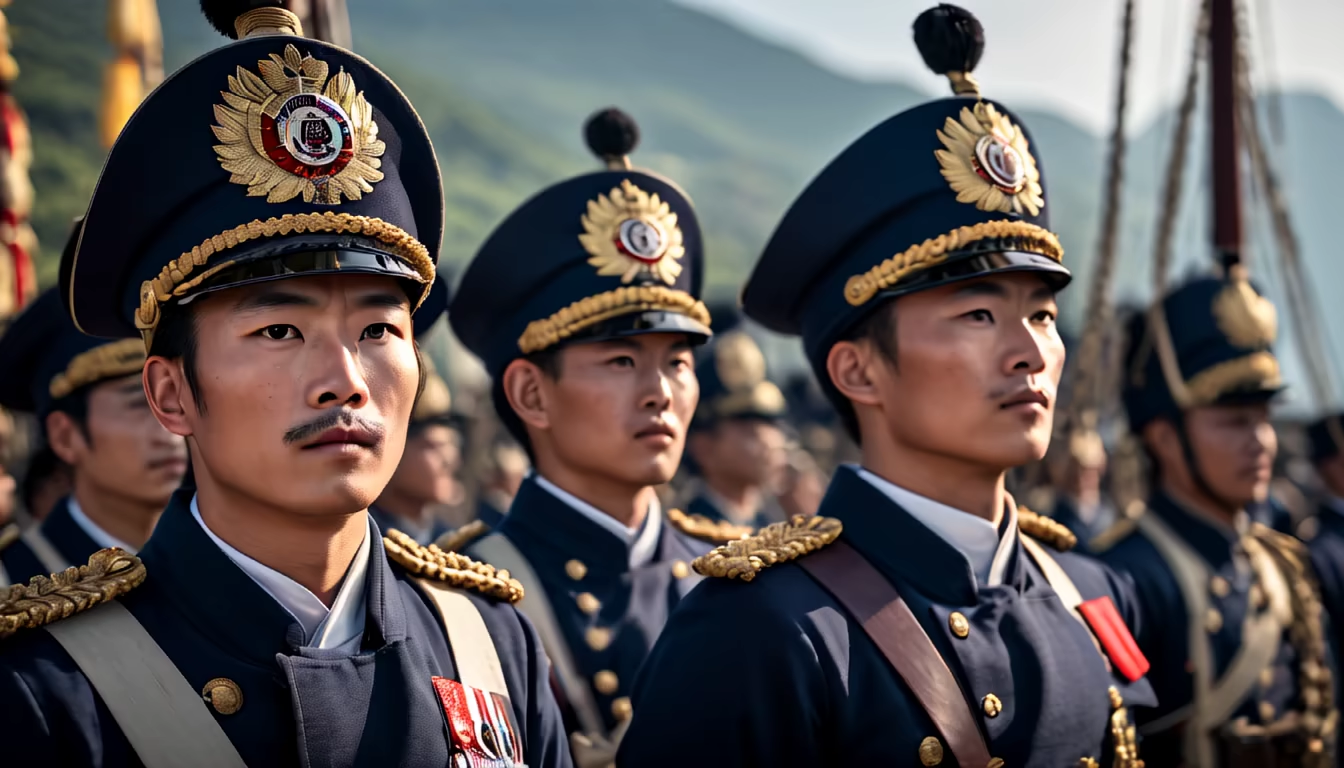
Prompt: Set against a backdrop of the bustling Victoria Harbour, a historic ceremony unfolds. Representatives from Qing China and the British Empire stand on opposite sides of a grand table adorned with maps and documents. With a backdrop of ornate silk banners, the pivotal moment arrives—the handing over of this lush island to the British Empire. A sense of anticipation and uncertainty hangs in the air, marking the beginning of an era that will shape Hong Kong's destiny and its complex intermingling of cultures and histories. THE BACKDROP SHOULD BE DURING 1842 .
Style: Photographic
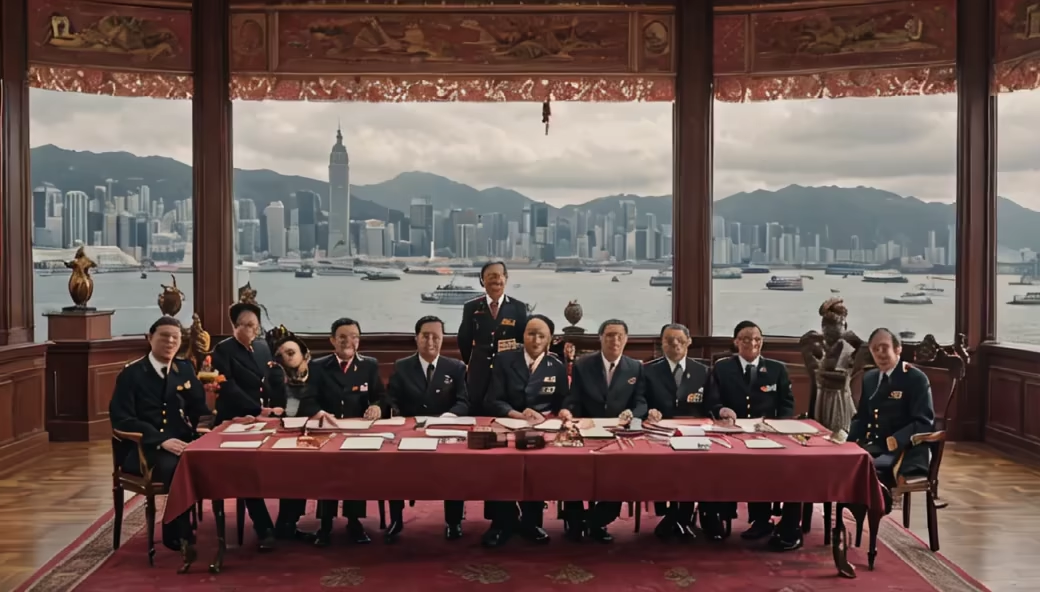
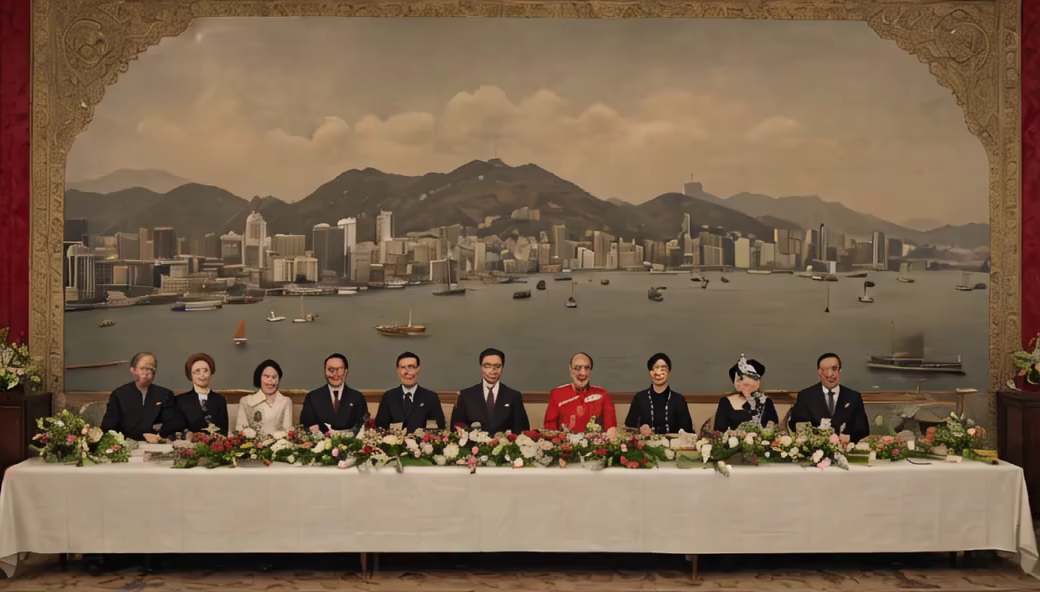
Prompt: The image depicts a scene of sorrow and despair in China during the Opium War era. Chinese civilians are shown in disarray, some mourning, while others gaze in dismay at the destruction around them. In the background, British forces loom, their modern weaponry and imposing presence symbolizing the overwhelming power that led to the \"Century of Humiliation.\" The image encapsulates the shattered pride and vulnerability of the Chinese nation during this period of turmoil caused by misguided trade policies and devastating warfare.
Style: Digital Art
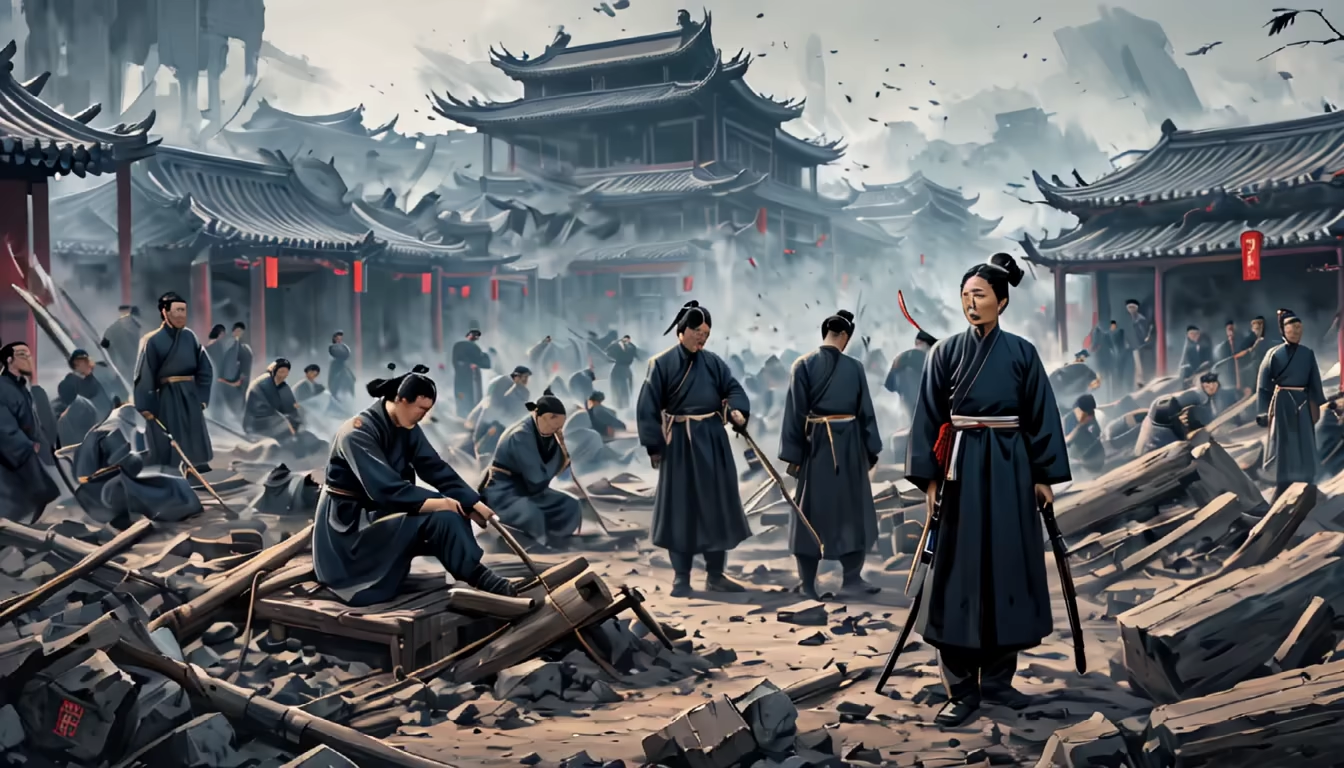
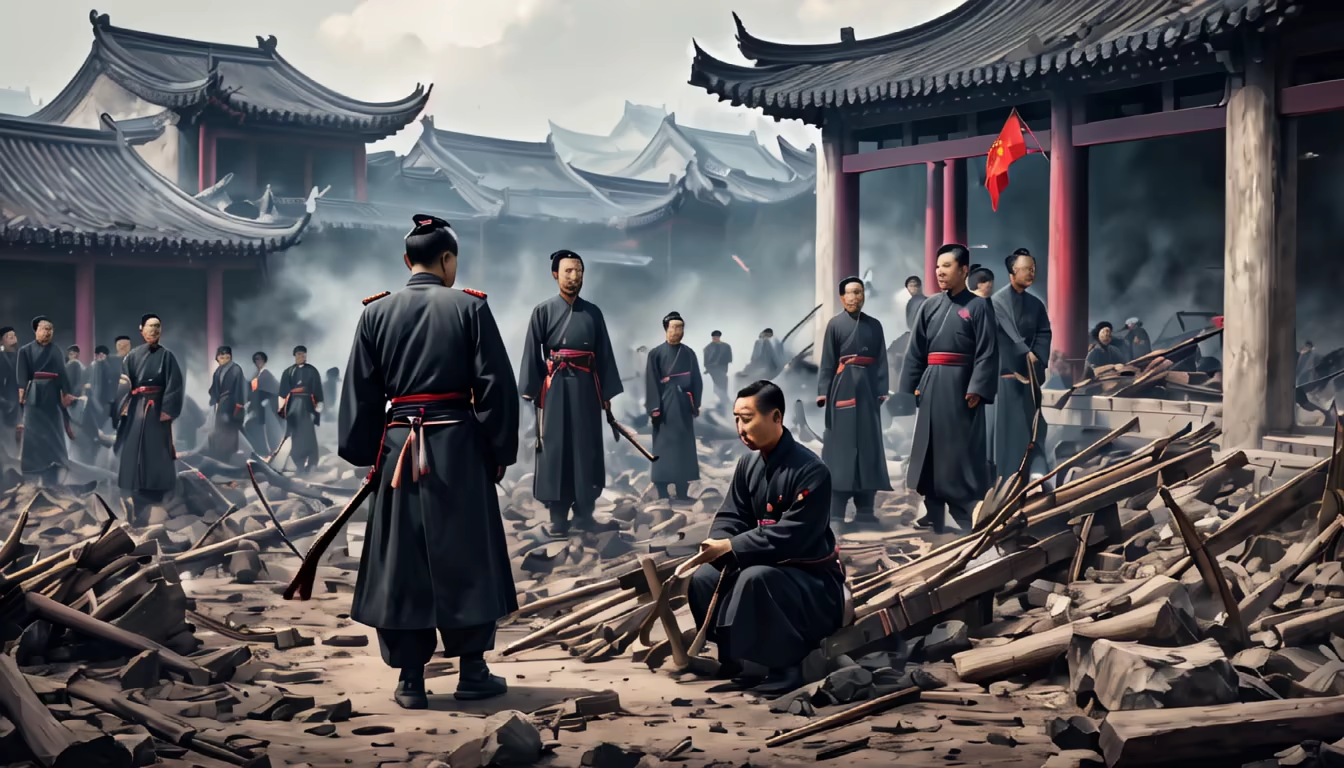
Prompt: Imagine a series of sequential illustrations showcasing the progression of the battles. Begin with an imposing British naval fleet dominating the waters, cannons firing and ships advancing, while smaller, outdated Chinese vessels struggle in the background. The subsequent images could depict key moments of the battles at Tamao, Chuanbi, and Bogue, highlighting the British fleet's overwhelming firepower and strategic maneuvers that led to their control over the waterways. Show the Chinese ships attempting to resist but ultimately being outmatched, symbolizing the technological and strategic disparity between the two forces.
Style: Cinematic
